



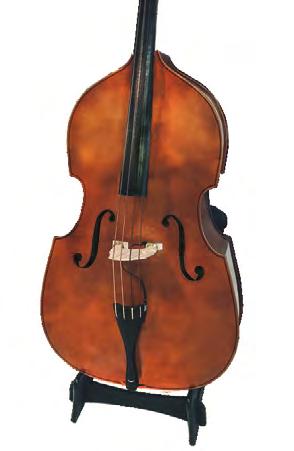
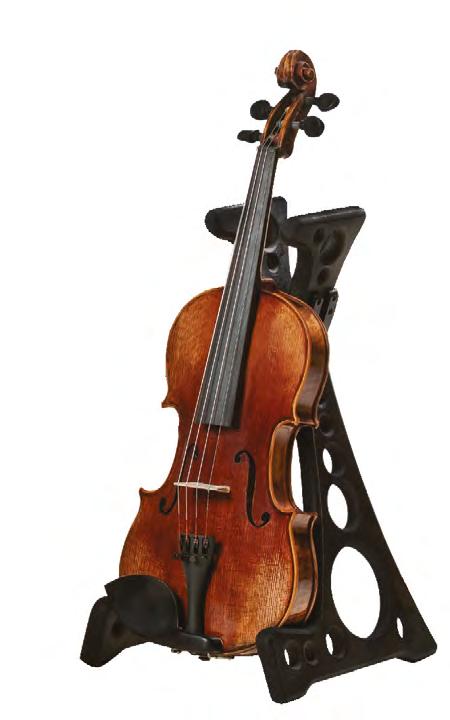


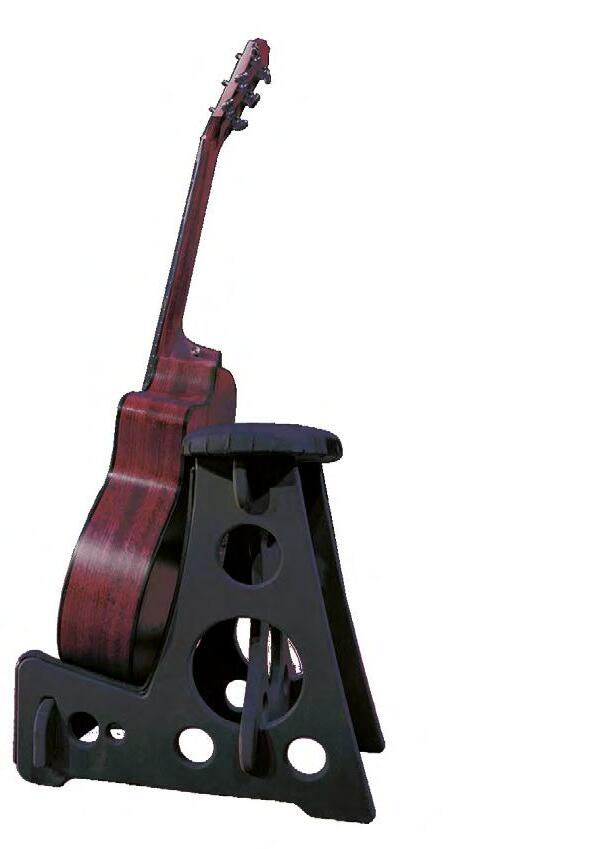
Follow us on: RCWilliamsCompany.com | 913.912.1083 Available in red for an extra splash of color. ©2022 RC Williams Company, LLC. Designed and manufactured by RC Williams. All rights reserved. DESIGNED FOR YOUR BEST PERFORMANCE Find out more about our innovative products today! THE AMAZING DBL BASS BUGGIE® We’re home of the original double bass transport. THE AMAZING BASS STAND Keep your upright bass secure and a comfortable seat while you’re performing. STUDIO G STAND A versatile option for guitarists in the studio or on the stage. Protection for your instrument and comfort for the performer. THE AMAZING MINI X STAND Unique hinged “x” format for smaller stringed instruments such as violins, violas, mandolins, and most ukuleles. Available in multiple heights and natural finish. 2

3


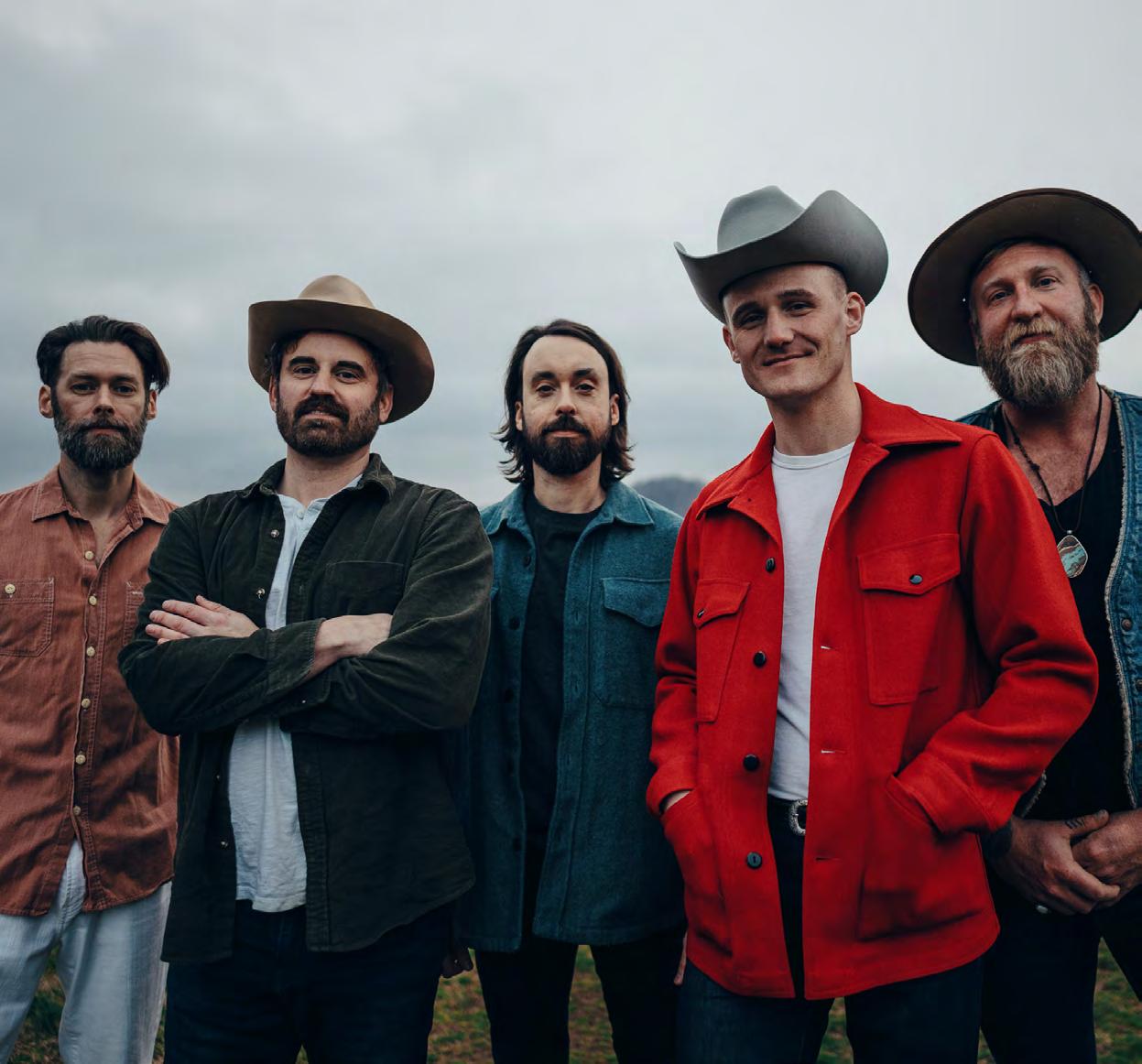
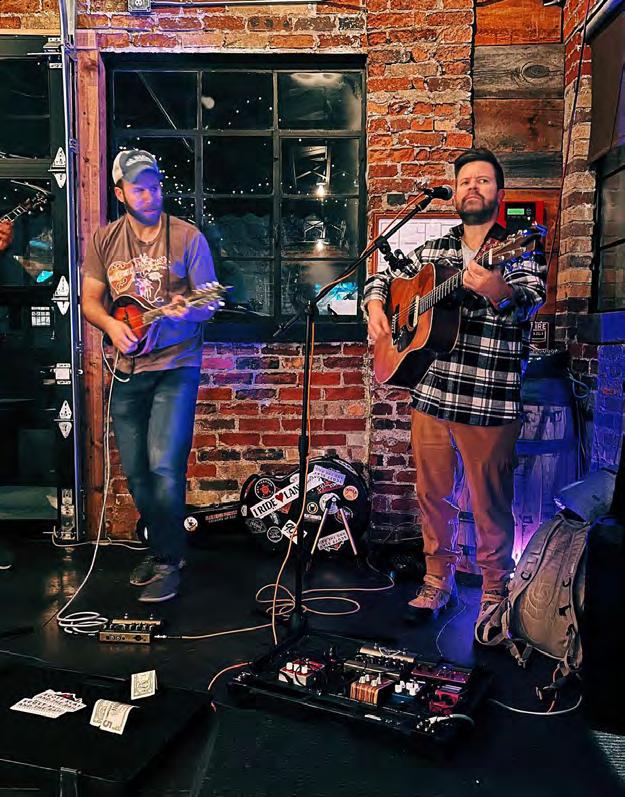
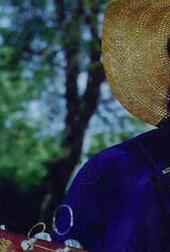

32 41 22 4
OUR CHOICE
The Bluegrass Standard is a life-long dream of Keith Barnacastle, who grew up in Meridian, Mississippi. For three years, Keith brought the Suits, Boots and Bluegrass Festival to Meridian. Now, with the Bluegrass Standard, Keith’s enthusiasm for the music, and his vision of its future, reaches a nationwide audience every month!

Keith@TheBluegrassStandard.com
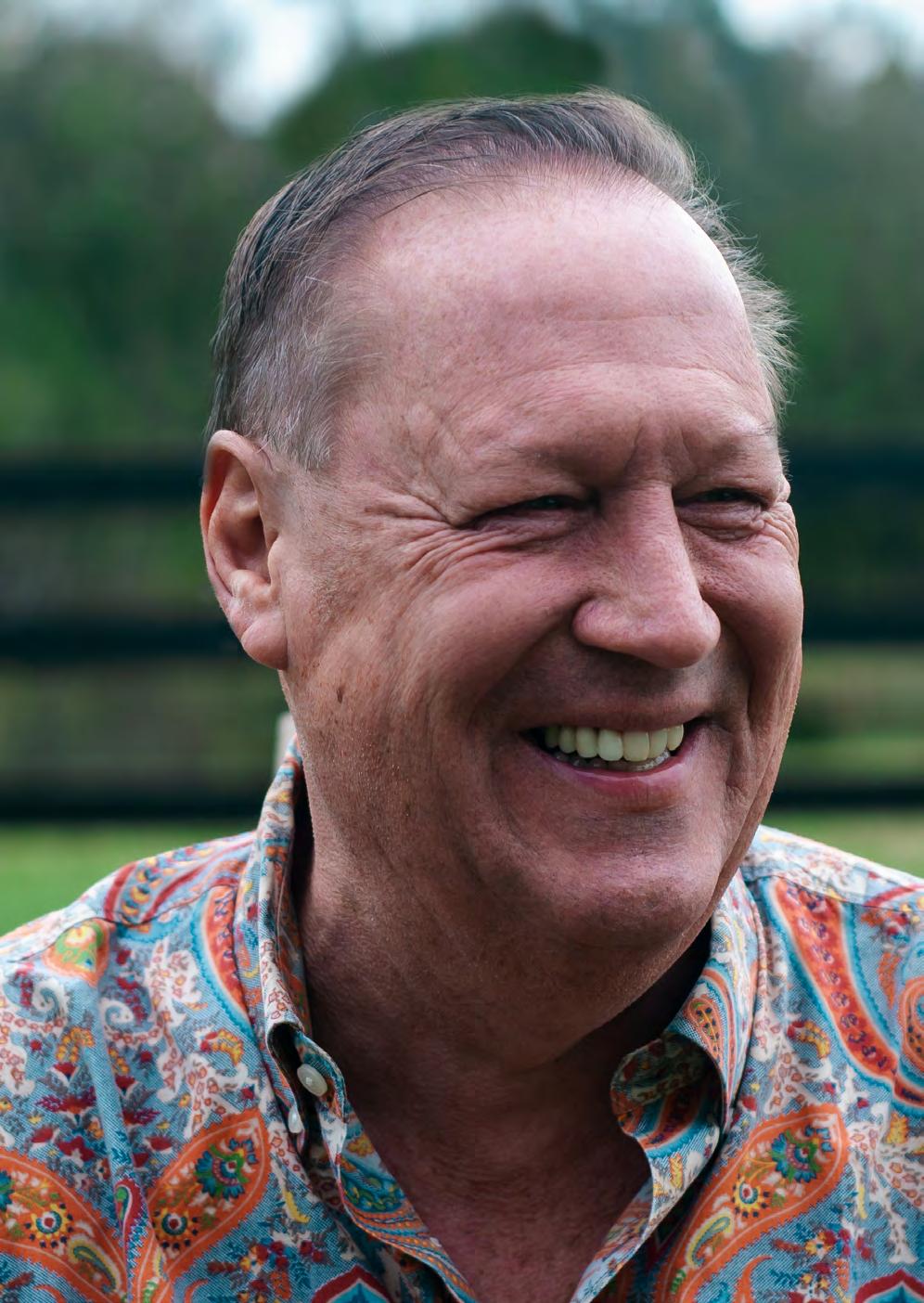
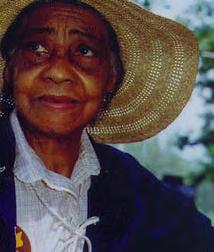


16 5 CONTENT 7 MILE BLUEGRASS 08 CATFISH IN THE SKY 12 ELIZABETH COTTON 16 GANGSTA GRASS 22 GRACE VAN’T HOF 28 HOGSLOP STRING BAND 32 JAMON SCOT 36 SCOTT SLAY 41 THE LONE BELLOW 46 TALISK 52 THE CROOKED JADES 56 FOOD MARKETS 62 FAN PHOTOS 66
28
Keith Barnacastle • Publisher
Our Staff
Richelle Putnam • Executive Editor/Writer

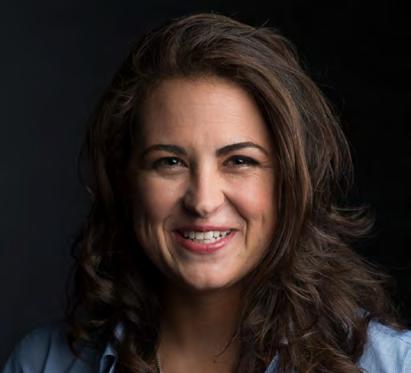
Richelle Putnam is a Mississippi Arts Commission (MAC) Teaching Artist/Roster Artist (Literary), a Mississippi Humanities Speaker, and a 2014 MAC Literary Arts Fellowship recipient. Her non-fiction books include Lauderdale County, Mississippi; a Brief History, Legendary Locals of Meridian, Mississippi and Mississippi and the Great Depression. Richelle@TheBluegrassStandard.com
Rebekah Speer • Creative Director
Rebekah Speer has nearly twenty years in the music industry in Nashville, TN. She creates a unique “look” for every issue of The Bluegrass Standard, and enjoys learning about each artist. In addition to her creative work with The Bluegrass Standard, Rebekah also provides graphic design and technical support to a variety of clients.
Susan Woelkers • Marketing
Susan traveled with a mixed ensemble at Trevecca Nazarene college as PR for the college. From there she moved on to working at Sony Music Nashville for 17 years in several compacities then transitioning on to the Nashville Songwritrers Association International (NSAI) where she was Sponsorship Director. The next step of her musical journey was to open her own business where she secured sponsorships for various events or companies in which the IBMA /World of Bluegrass was one of her clients.
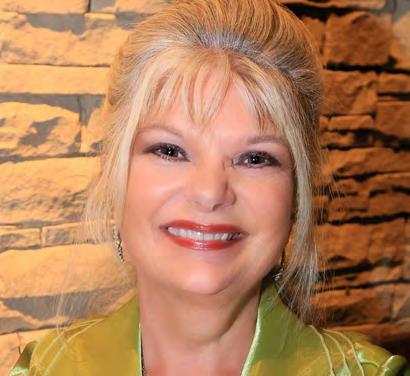
Brent Davis • Contributor
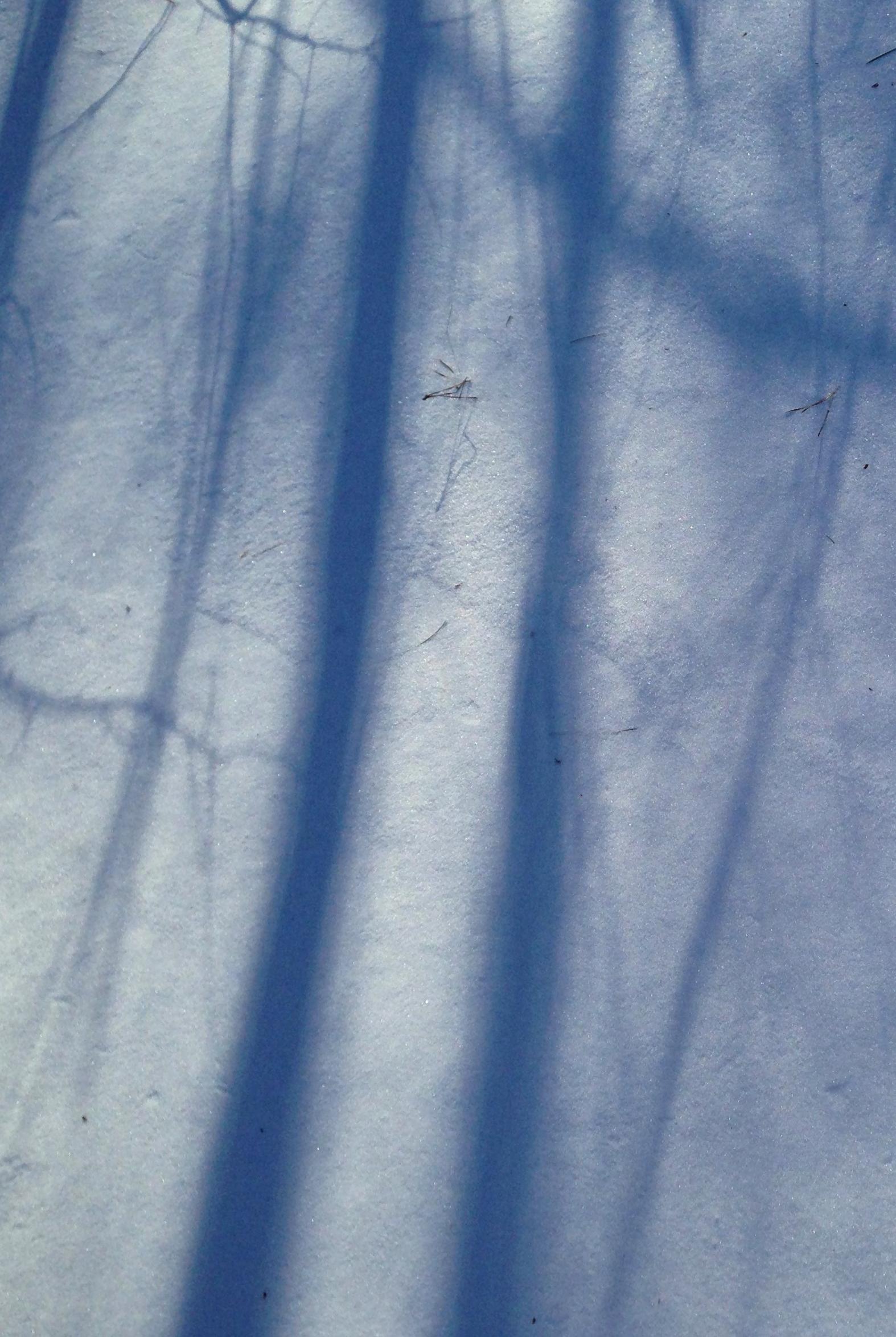
Brent Davis produced documentaries, interview shows, and many other projects during a 40 year career in public media. He’s also the author of the bluegrass novel Raising Kane. Davis lives in Columbus, Ohio.

6
Mississippi Chris Sharp • Reviewer
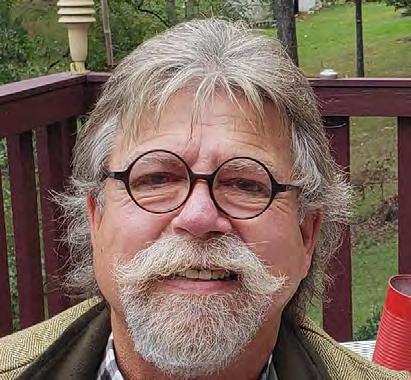
Singer/Songwriter/Blogger and SilverWolf recording artist, Mississippi

Chris Sharp hails from remote Kemper County, near his hometown of Meridian. An original/founding cast member of the award-winning, long running radio show, The Sucarnochee Revue, as featured on Alabama and Mississippi Public Broadcasting, Chris performs with his daughter, Piper. Chris’s songs have been covered by The Del McCoury Band, The Henhouse Prowlers, and others. https://mississippichrissharp.blog
Susan Marquez • Journalist


Susan Marquez is a freelance writer based in Madison, Mississippi and a Mississippi Arts Commission Roster Artist. After a 20+ year career in advertising and marketing, she began a professional writing career in 2001. Since that time she has written over 2000 articles which have been published in magazines, newspapers, business journals, trade publications.
Kara Martinez Bachman • Journalist

Kara Martinez Bachman is a nonfiction author, book and magazine editor, and freelance writer. A former staff entertainment reporter, columnist and community news editor for the New Orleans Times-Picayune, her music and culture reporting has also appeared on a freelance basis in dozens of regional, national and international publications.
Candace Nelson • Journalist
Candace Nelson is a marketing professional living in Charleston, West Virginia. She is the author of the book “The West Virginia Pepperoni Roll.” In her free time, Nelson travels and blogs about Appalachian food culture at CandaceLately.com. Find her on Twitter at @Candace07 or email CandaceRNelson@gmail.com.
7
Brent Davis
7 Mile Bluegrass


8
Although Billy Self had played in a bluegrass band for several years, he says he didn’t know anything about putting on a bluegrass festival. But a desire to help struggling veterans--including a nephew-led him to create a festival in 2019 near Chillicothe, Ohio, that now attracts national acts and continues to grow.
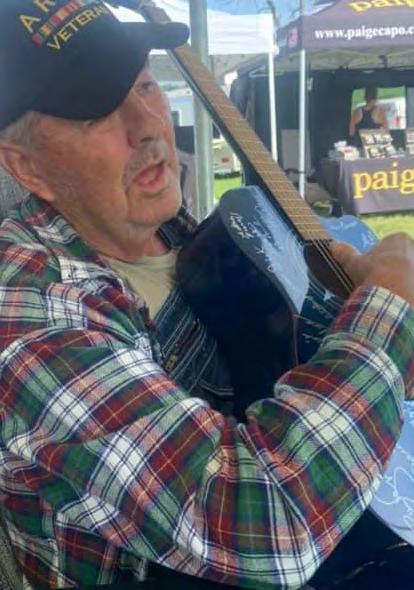
Instead of an entrance fee, Self asks attendees to bring six items of nonperishable food that will be used to help feed local veterans.
“The best part of it is when you get at the end of it and you see how much food you collected,” Self says. “It’s great to take the food to the pantries so you actually see what you work your tail off for.”
7 Mile Bluegrass is not only the name of the festival, but of the band Self, a guitar player, singer, and songwriter, started in 2013. He and a band mate lived seven miles from each other, hence the name. A local landowner had asked him to establish a bluegrass festival on his property. Self agreed once he realized he could gather food for veterans.
“The first year we didn’t have any support. It was me and my brother and the band. We expected, you know, a hundred people. And I hired what bands I could afford. Me and my brother paid a lot of money out of our own pocket to make it happen. And we had some friends that helped sponsor it. And we had close to
1200 people.”
Additional sponsors signed up the second year and attendance more than doubled.
“We weren’t expecting a big crowd,” Self recalls. “I’m like, ‘Wow, this, this is pretty cool!’ We raised a lot more food and filled some trucks for the VA.”
Now a 501 C-3 has been established to support the festival and there’s a team in place to make it work.

Among the artists coming to this year’s festival, which takes place July 27-29, are the Lonesome River Band, Little Roy and Lizzie, Junior Sisk, My Brothers Keeper, Echo Valley, and Prairie Wildfire.
“The Prairie Wildfire girls are coming up from Wyoming and in addition to playing they’re going to give some lessons,” Self explains. “They said, ‘We’re going to take a donation and put it towards the festival.’ So I thought that was great.” Self says some people come to the festival because they want to help the veterans but don’t know much about bluegrass. And they get hooked.
“It’s family friendly, the camping’s free, and you can put your camper anywhere you want as long as we can get it in,” Self says. “You can put up a tent in the shade. And the jamming never ends. You can wake up at six in the morning and there’s still people out there jamming.
9

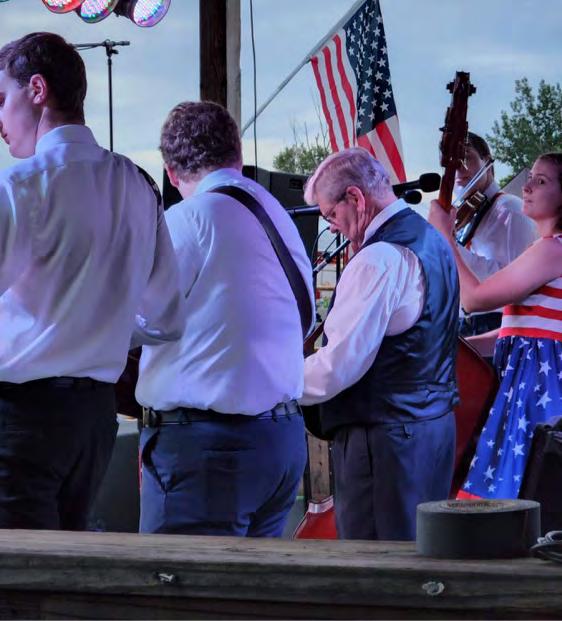
10
“I didn’t think I’d make it this far as an amateur. I didn’t know anything about running a festival, but we’ve got some good bands and everybody’s excited to come out.”

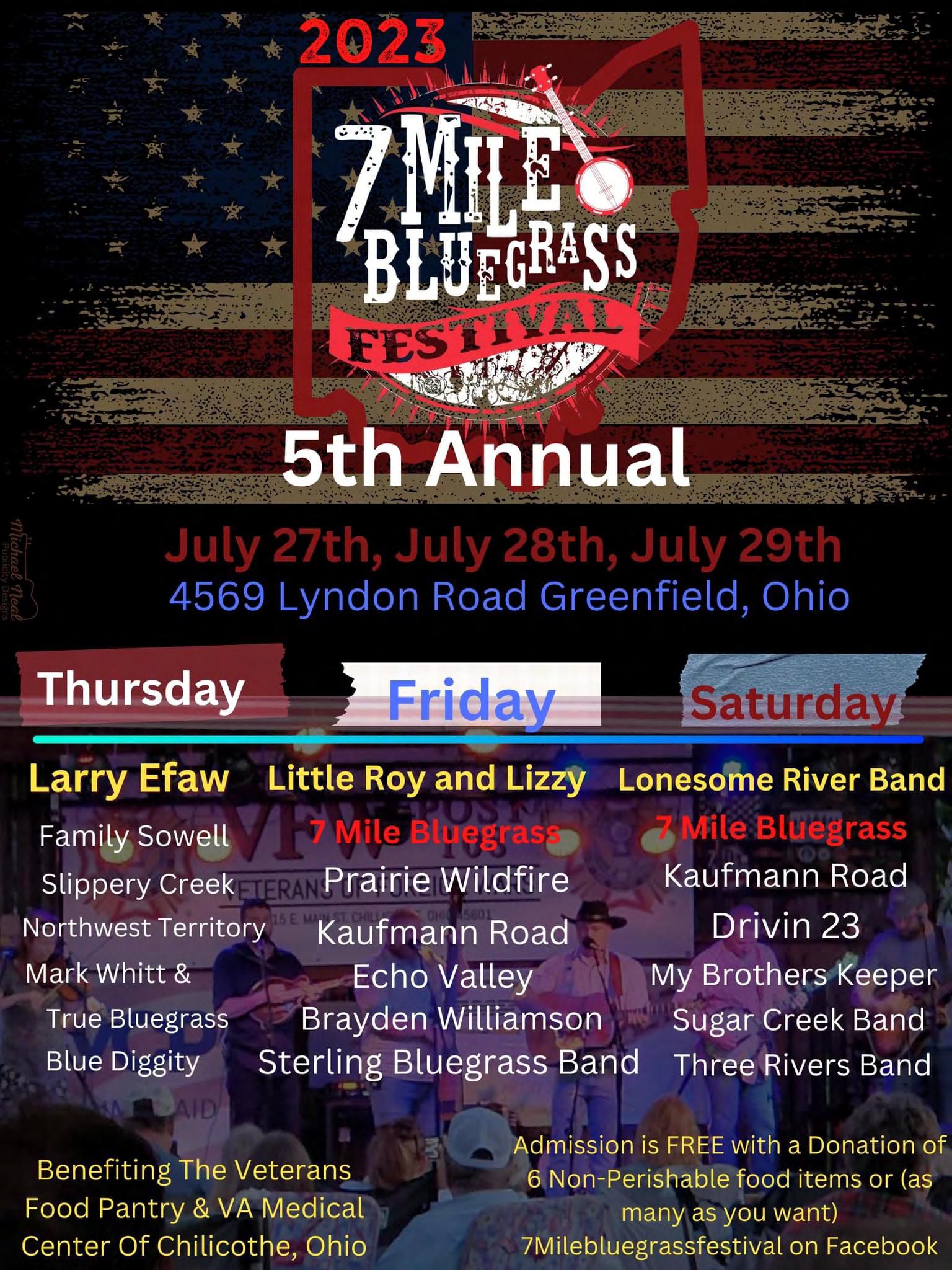
11
Catfish In
When Ruth Shumway taught her classmates at Berklee a bluegrass tune by Steve Rosen called Nail that Catfish to a Tree, they were enthralled with the name of the song. So much so, when they officially formed their band, they used a riff of the song’s title for the band’s name.
Ruth, a North Carolina native, has been playing fiddle since she was three years old. Like most young children who play the violin, she started with music lessons using the Suzuki method. Ruth took to the fiddle like a duck to water. “When I played my first recital, I loved it so much I didn’t want to leave the stage. I just kept bowing to the audience with my little violin.” Her violin teacher suggested that Ruth’s parents take her to a fiddle contest at Fiddler’s Grove, which was near to their home. “I loved everything about it. My parents actually got into bluegrass because of my love for it. I dragged them all over to hear bluegrass music. I still go to Galax whenever I can.”
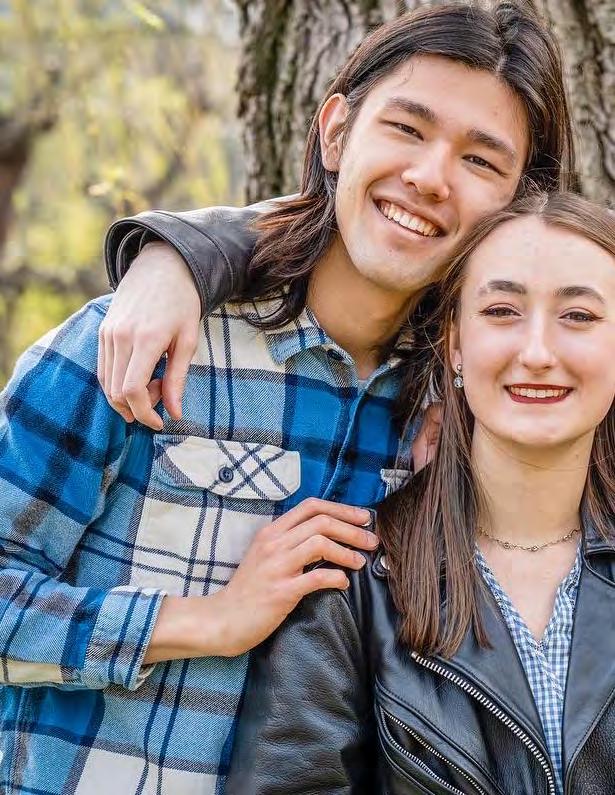
12
In The Sky
When she was eight years old, Ruth went on a trip to Boston with her parents and she saw the Berklee School of Music. “I knew then that’s where I wanted to go to school someday.” Now Ruth is in her second year at Berklee. She met the other members of Catfish in the Sky as a freshman. “We all lived in the same dorm and became friends.”
Owen Miller, a Massachusetts native, is the percussionist for the band. He plays the cajon, an instrument of Peruvian origin that resembles a big wooden box. The player sits on top and hits the front of the box, and depending on where or how it is hit, different sounds are created. “Although my cajon is made in Peru, the type of cajon I have is called a Flamenco cajon, which originated when a Spanish guitarist saw the instrument and added guitar strings to the inside.” Owen is studying to be a music therapist. “He has a singer-songwriter background,” says Ruth. “Owen is very talented.

13
Susan Marquez
The songs he writes are really wonderful.”

Sammy Wetstein is a multi-instrumentalist from Connecticut who plays cello in the band. He began playing classical cello in the fourth grade. He plays mainly classical, jazz and fiddle/folk music, and enjoys learning about various types of traditional music and its role in cultures around the world. Sho Humphries, from Connecticut, rounds out the band on ukulele. A world champion ukulele player, Sho’s mission is to play the ukulele in a way that has never been done before while spreading smiles and infections melodies. “Sho brings a fun energy to the band,” says Ruth.
In fact, Ruth describes the band as having incredibly high energy. “We couldn’t stand still on a stage if we had to,” she laughs. Because everyone in the band has a different musical background, the band plays a variety of music, from Celtic and bluegrass, original tunes, and jazz. “Of course, jazz,” says Ruth. “We are, after all, from Berklee.” Putting songs together in an artistic way is what makes the band unique. “We always try to put a unique spin on whatever we are playing. We do a lot of fun covers of songs that aren’t necessarily bluegrass, but because I’m a bluegrass girl at heart, we give them a lively bluegrass feel. It always seems to work. Everyone is a stellar, off-the- chart musician.”
Catfish in the Sky can be seen playing in venues around the Boston area, in bars and other venues. “We also play in shows through the school. And when the weather is nice, we all enjoy busking. We love any opportunity we have to play.”

Folks attending IBMA in Raleigh last fall had an opportunity to hear Catfish in the Sky play in a showcase. “I have been to IBMA several times, but the others in the band had never been.” It was a perfect way for them to be immersed in the music that had so heavily influenced Ruth’s musical tastes. “We drove from Boston to Raleigh, twelve hours, to play at IBMA.” Ruth recalls that Sammy’s cello wouldn’t quite fit in Owen’s car, which they drove from Boston to Sammy’s home in Connecticut. “Sho and Sammy rode the whole way in the back seat with the cello in their laps.” They switched cars in Connecticut for the rest of the journey. As difficult as that was, the trip back to Boston was almost derailed. “The night before we were going home, I had a fever of over 100 degrees,” says Ruth. “Sammy stayed up until 5:00am and we were supposed to leave early that morning. Sho didn’t have a driver’s license, and no one wanted Owen behind the wheel. “I was a danger to myself and others,” he adds. But in the end, they were able to make the trip. “We had a great time at IBMA,” says Ruth. “We plan on going back again next year.”
The band is currently in the studio working on an EP. “It will have five songs,” says Ruth. “We are fortunate that Berklee has great recording studios available, and students who are learning production. We have some wonderful friends helping us.” The EP’s working title is “We’re a Wreck.”
14

15
Elizabeth Cotton
Some may call Elizabeth Cotton a late bloomer. After all, the singer/songwriter didn’t start performing publicly or recording until she was in her sixties. That may not have happened at all had it not been for Elizabeth being in the right place at the right time.
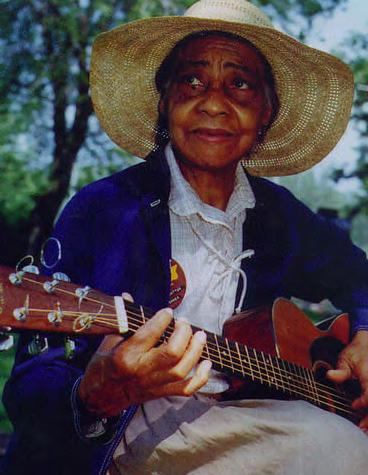

In the early 1950s, Elizabeth was divorced and working in a department store in the Washington, DC, area. When young Peggy Seeger, the child of composer Ruth Crawford Seeger, was lost and wandering through the aisles of the store, Elizabeth helped reunite the young girl with her mom. Ruth was grateful, and soon she and her husband, Charles, hired Elizabeth to work as a maid. She then became the couple’s nanny, helping to care for their four children and Pete Seeger, Charles’ son from a previous marriage. To entertain the children, Elizabeth (or “Libby,” as they called her) remembered the guitar she played as a child forty years prior.
Elizabeth was born into a musical family like the Seeger children she cared for. She
16
Susan Marquez
was born in Chapel Hill, North Carolina, in 1893. Her parents encouraged Elizabeth as she played with her brother’s banjo as a child. But times were hard for the Nevill family, and Elizabeth, the youngest of five children, quit school when she was nine years old to work as a maid. When she was twelve, she worked as a live-in maid for a family in Chapel Hill, earning one dollar a month. Her mother saved the money for her and used it to buy the child a guitar from Sears and Roebuck. No one taught Elizabeth to play the guitar; she figured it out on her own and became so accomplished on the guitar that she developed an extensive repertoire of dance tunes and rags, songs typically composed for and played on the piano. When Elizabeth was in her early teens, she began writing original songs. One of her most recognized songs, “Freight Train,” was inspired by a train she heard daily near her childhood home.
While working for the Seeger family, Elizabeth picked up the guitar again. Since it had been decades since she played it, she taught herself to play again from scratch. People were fascinated when they watched her play – Elizabeth was left-handed and played her guitar upside down. During the latter half of the 1950s, Mike Seeger, the oldest of the Seeger kids, began making reel-to-reel recordings of Elizabeth’s music in the bedroom of her house. The recordings were released on an album, “Folksongs and Instrumentals with Guitar,” on the Folkways Records label. The album hit at the right time—the onset of the American folk music explosion.
Many of the day’s popular folk artists not only listened to the album but recorded “Freight Train” and other songs from the album. These artists include Peter, Paul and Mary, Jerry Garcia, Bob Dylan, Joan Baez, Laura Viers, Taj Mahal, Doc Watson, and Ester Ofarim, who recorded a French version of the song in 1965.

The Seeger family impacted Elizabeth’s life and musical career significantly. Peggy Seeger, the child Elizabeth found in the department store, grew up heavily influenced by her musical parents. She took Elizabeth’s song, “Freight Train,” to London. The song became popular with folk musicians there, and two British songwriters, Fred Williams and Paul James, claimed the song as their composition, and they copyrighted it. When “Freight Train” was recorded by Chas McDevitt and Nancy Whiskey in England in 1956, the song became a major hit. Some said the song was one of the main influences for the popularity of skiffle, a blend of blues, country, bluegrass, folk music and jazz that was all the rage in the UK in the early 1950s. Skiffle inspired the music of several bands, including The Quarrymen, a band formed by John Lennon that evolved into The Beatles. The band played “Freight Train” in their early gigs, with John Lennon singing.
The Seeger family wanted to ensure Elizabeth got her due, and they used their influence to get the song’s copyright returned to her. The Seeger family also helped launch Elizabeth’s performing career. After the release of her first album, Elizabeth played in a concert with Mike Seeger at Swarthmore College in Pennsylvania. It was 1960, and it was the first time, except for singing in church, that Elizabeth had performed on a stage. She was 67 years old. She would perform many more times on stage, playing in concerts with some of the big names in the blossoming folk music revival. She played with Mississippi John Hurt, John Lee Hooker and Muddy Waters.
17
She played on stage at the Newport Folk Festival and the Smithsonian Festival of American Folklife.
Elizabeth was encouraged by the interest in her music and wrote more songs to perform. In 1967, in collaboration with her grandchildren, she released a record, “Shake Sugaree.” The title track featured her great-grandchild, Brenda Joyce Evans, who was twelve then.
Elizabeth toured and released records well into her 80s and received many awards and honors for her music. In 1984, she received the National Heritage Fellowship awarded by the National Endowment of the Arts, the highest honor in the folk and traditional arts bestowed by the United States government, and the GRAMMY award for Best Ethnic or Traditional Recording. At age 94, Elizabeth Cotton died in June 1987 in Syracuse. Her music is still relevant today - she was posthumously inducted into the Rock and Roll Hall of Fame just last year.


18


19

20

21
The Bluegrass Standard/Turnberry Records
Gangsta Grass

22
While some people take music very seriously, sometimes it’s just about being fun. Bluegrass music is fun. Hip-hop music is fun. Combining the two? Yeah, that would be fun.
At least, that’s what Brooklyn-based, Emmy-nominated, Billboard charting musician and producer Rench thought. “I could only imagine what it would sound like. I knew if I ever had a chance to do it, I would call it ‘Gangstagrass.’ I had been listening to Ralph Stanley and the Clinch Mountain Boys and some early Union Station. I couldn’t tell if it was blues or country or what. But I couldn’t stop imagining what it would sound like with some rap vocals and beats.”
When he met banjo player Dan Whitener (Man About a Horse), Rench could feel his Gangstagrass idea come to life. Rench produced Dan’s folk-soul album, Crossover, and one of the tracks from the album was used in the Spike Lee film Black KKKlansman. The two musicians talked about the idea, and Dan was on board. The result was an album Rench put on the internet for free: Rench Presents: Gangstagrass, and people took notice.
It wasn’t long before the producers of a new show on FX Networks, Justified, called upon Rench. “They wanted that sound for the show,” he says. The show’s theme song, “Long Hard Times to Come,” garnered an Emmy nomination in 2010. Dan was born and raised in Washington, DC and is active in the music scene in New York, New Jersey and Pennsylvania. B.E. Farrow came on board in a
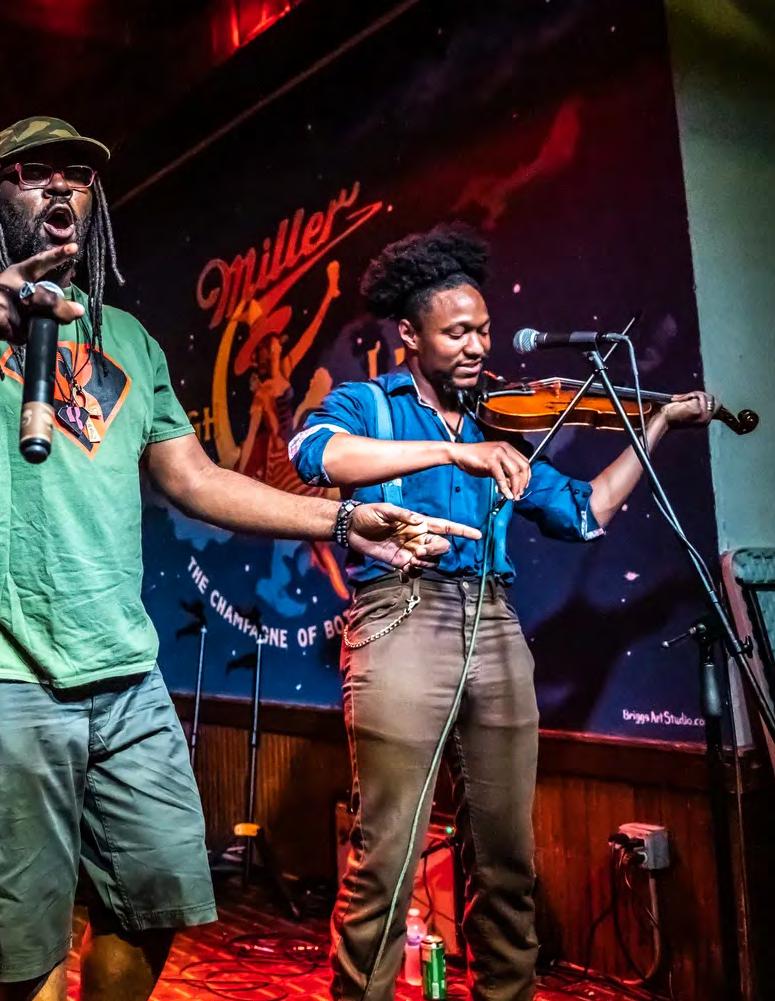
23
Susan Marquez
roundabout way. He played jazz and classical on the upright bass and unexpectantly happened upon a bluegrass band playing in a punk bar. They called him up when they needed a bass player, and he played with them at a big bluegrass festival. B.E. was friends with Gangstagrass’s manager, and she encouraged him to check out their music. “I was already a hip-hop fan, and the lyricism convinced me to give it a try for a while.” He has been with the band ever since.
The interesting thing about Gangstagrass is that it is both genre-bending and a conversation starter, and the conversation can be challenging to some folks. “We work hard to blend this into a kind of soup that is the most genuine blend of all our backgrounds,” says Dan. “We are combining stuff that has never been combined. When you try to pin us down to a certain genre, it’s impossible. The whole idea of genre is a historical invention. B.E. says that he really isn’t a bluegrasser. “I’m more of an old-time musician, but I can hang on to a bluegrass tune, probably because I know jazz. All music is just twisted branches from the same tree. Dolio is more Southern hip-hop. R-Son, the Voice of Reason is from the Philly scene.” Culture comes from broadly sourced materials. “I used to raid my parents’ record

24
cabinet when I was a kid,” recalls Dolio. “I grew up with a juke joint behind my house. We watched Soul Train on Saturday night and Hee Haw on Sunday. You can’t tell me ‘The Devil Went Down to Georgia’ isn’t cool.”
As off the beaten path as they may seem, Gangstagrass has received a large share of mainstream attention. The band has played in Owensboro and on the PBS Bluegrass Underground series. They were a massive hit at the Folk Alliance International conference a few years ago and last year at IBMA. “We did America’s Got Talent in 2021,” says Dan. “They weren’t sure what to do with us. It was great to see the surprise on their faces. It’s better to experience it than to explain it.”
The band members have realized that the musical genres, and their audiences, seem to have more in common than not. Music can be a powerful unifier; through their music, Gangstagrass is helping people share their roots and experiences as Americans.
Gangstagrass has produced four studio albums and one live album, and their popularity continues to grow. Their biggest challenge came during the Covid

25
epidemic. They had to make it work. “We set everyone up with a home studio,” recalls Rench. Rench, who said he was jealous of the duos some sent in. “We did live streams via Zoom, and Time for Enemies.
Dan said the album made during that time was a testament to the group’s strength. “We had recorded three songs and were rehearsing more, so that was helpful to us.” Dolio says the time was therapeutic. “We all missed each other. We were fueled by what the into touring in 2021, we all got Covid.” Dan added that it taught them balance. “We had to
The future is bright for Gangstagrass. They released a holiday album last year, and more projects bending music. “There are more people out there with both Jay-Z and Johnny Cash on their
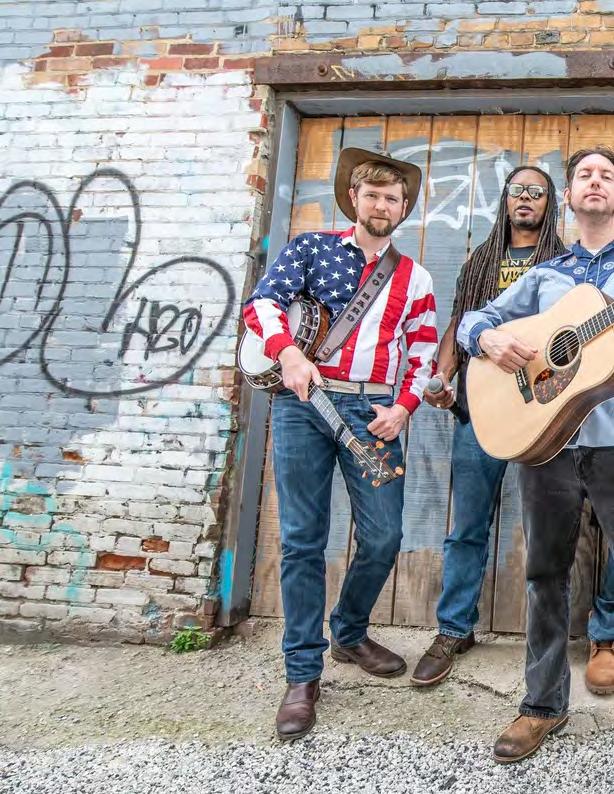
26
Rench. “I think we all picked up recording skills along the way.” Everyone sent their files to and we did pre-recorded things. We just made it work.” The result was an album called No
had all been going non-stop for years, and then we came to a dead stop. We had already the album became – it was topping the Billboard charts. When we were able to inch back to learn how to be safe.”
projects are on the horizon. Rench believes there will always be an audience for genretheir iPod than you might imagine.”

27
Grace Van’t Hof

28
For most bluegrass band members, double duty means playing an instrument and driving the bus. Banjoist Grace Van’t Hof not only contributes to the sound of Chris Jones and the Night Drivers; she’s responsible for the band’s latest album cover. Indeed, she’s worked with numerous artists, festivals, and organizations to create compelling posters, album art, logos, and other visual elements. Her work has earned her the distinction of being the International Bluegrass Music Association Graphic Designer of the Year for the last two years.
“My mom’s a very talented artist, and she said I showed a proficiency for it at a young age,” Van’t Hof recalled. “Art’s always been a thing for me.”
Growing up in Holland, Michigan, a science fair-styled event called Science Olympiad introduced Van’t Hof to the banjo. With her father’s help, she constructed a banjo to participate in a category called “Sounds of Music.”
“The banjo we ended up building was a little complicated and not super playable, but the sound just really got me. Once I heard that sound, I was really hooked.”

There wasn’t much bluegrass music near Holland. Van’t Hof would travel two and a half hours to jam. And since that group had a banjo player, she switched to Dobro.
Van’t Hof studied art and biology at Calvin University in Michigan when she got a public performance scholarship in Dobro at East Tennessee State University. A friend introduced her to fiddler Kimber Ludiker, who would become the founder of the groundbreaking all-female band Della Mae. Van’t Hof was one of the original members.
“Everybody who’s been through that band is incredibly talented,” Van’t Hof said. “It was really inspiring, if not a little intimidating. I appreciate the time I got to spend with them.”
Van’t Hof had relocated to Boston when she joined Della Mae. After two years, she left the band and eventually returned to East Tennessee, where she was a founding member with Kris Truelson of Bill and The Belles.
“I’ve always been into early, pre-bluegrass country music, especially some of the 30s and 40s country, but especially, the music of Jimmie Rodgers and sort of adjacent characters like Clayton McMinchen and some of those blues and jazz guys that overlapped with Jimmie. And Bill and The Bells was really into that kind of music. And that was awesome.”
During this time, Van’t Hof apprenticed with an artist and began working as a graphic designer and illustrator. After leaving Bill and The Belles, Van’t Hof returned to Michigan. That’s when Chris Jones called and asked her to join his band. She’s prominently featured in the Night Drivers on banjo, baritone ukulele, and as a vocalist. She did the cover art for the band’s Make Each Second Last album.
“It’s not part of my duties as a band member to do the artwork,” she explained. “I just prefer to do it because whatever artwork comes out with that band, people are going to assume I did it.”
Van’t Hof studied national park posters from the 30s for the Make Each Second Last cover. The various shapes that formed landscapes intrigued her. “They’re really color-blocky and beautiful
29 Brent Da vis
and supersaturated,” she observed. She described the cover as a “get out of town with your family” kind of poster. The speeding car she drew is modeled after one the band had posed with in a promo photo.

Van’t Hof’s graphic design work includes covers and posters for artists and organizations such as Mile Twelve, Twisted Pine, Frank Solivan, and Bluegrass Pride. Her portraits of banjoists BB Bowness and Charlie Poole are included in a set of Banjo All-Star Trading Cards. She created illustrations for the recently published book Well of Souls: Uncovering the Banjo’s Hidden History. She’s also excited about recently completing her first vinyl cover. “That’s like the berries for someone like me because it is so much more space, and you can include a ton more detail.”
In addition to her design work, Van’t Hof does live graphic capture during conferences, meetings, and other events, such as the recent String Band Summit at East Tennessee State University. The notes and illustrations she creates are shared with participants in real time. She sees parallels with playing in a band.
“It’s very improvisational. You hear something, and you have to translate it into something else. So, a lot of it is like in a bluegrass band when you are listening to the song, playing along with it while you’re sort of learning and then thinking about the solo you’re gonna make. And when I’m successful playing and when I’m successfully doing this graphic capture live-scribing thing, it’s a similar flow state. It feels the same.”
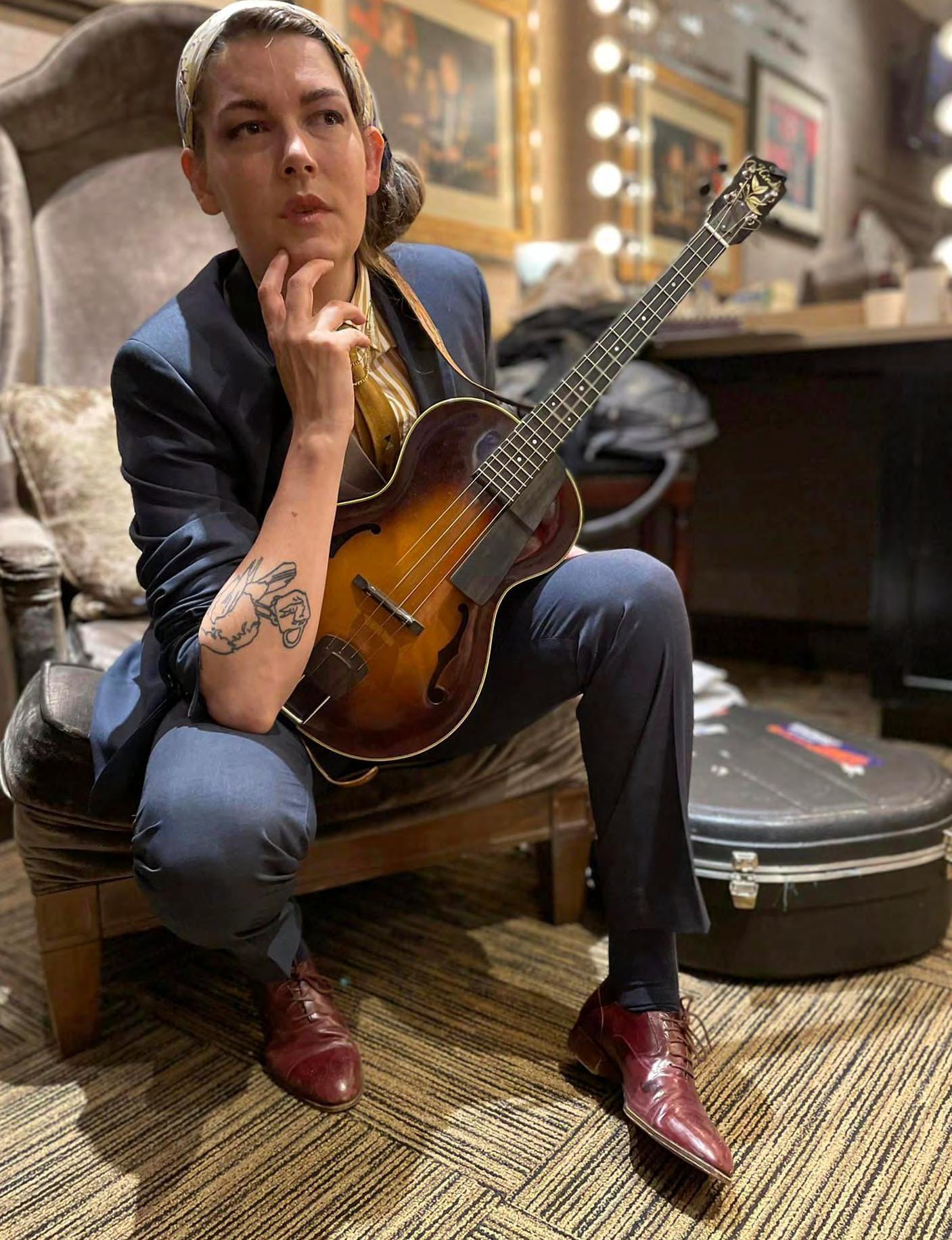
30


StringHogslopBand


32
A rollicking sound, paired with string music. It’s a riotous energy – a sonic rebelliousness – that finds its true soul in something akin to punk. Where punk succeeds in its energy, it often fails in its musicianship and its connection to deep-down roots. The Hogslop String Band steals that wild rock and punk spirit but offers alongside it an acoustic musicianship found only in the hands of capable performers. When this Nashville-based Americana outfit starts playing, you know it. You’ll never be bored watching this personality-filled group do its thing.


33
Kara Martinez Bachman
“The sound, energy, and musical chemistry was there from day one,” explained banjo player and vocalist Daniel Binkley, about what informs the band’s high-energy sound. “We found a common interest in more ‘rowdy’ string band music loaded with energy and often played fast. As we began to write original music, some material didn’t fit neatly into the traditional string band ‘box,’ but we still maintained the energy we loved in old fiddle tunes. What we’re doing now is an extension of that idea.” He added, “The lines of different genres seem to be blurring more and more in general, and we’ve come to think that if the music makes you feel good, that’s all that matters.”
An eclectic mix of life experiences and backgrounds amongst the band members no doubt contributed to the group’s sound. The lineup includes Kevin Martin (fiddle and vocals); Gabriel Kelly (guitar, harmonica and vocals); Will Harrison (mandolin, guitar and vocals); Daniel Binkley (banjo and vocals); and the single-named bandmate known as Pickle (bass, dancing and “general foolishness”).

“We all began playing as kids, guitar for most of us,” Binkley explained. “We have each been in a variety of bands over the years, ranging in styles from country to punk to blues.”
After coming together, they realized their unique combo of talents was worth building upon.
“At some point, you do have to decide to go all-in, which can be scary,” he said, “but I think each of us came to realize at some point that music was where we belonged, and other career paths just weren’t for us. That’s when the hard work begins!”
The hard work of the band includes both touring and recording. They were on the
roster for this year’s Bonnaroo Festival, and their upcoming schedule includes gigs such as the Under the Big Sky Festival on July 14 in Whitefish, Montana; a July 16 show with Elle King at the Old Saloon in Emigrant, Montana; and a July 18 appearance at Britt Festival Pavilion in Jacksonville, Oregon, also as an opener for Elle King.
They’ve released several recordings, including the eponymous 11-track album, “Hogslop String Band,” released in 2019. Their most recent release of this spring was the country single “Highs and Lows.”
“It’s the story of a classic on-again/off-again relationship and the desire to keep trying even when you know it probably won’t work in the end,” Binkley said. “I think we’ve all known someone in that kind of situation, right?”
As far as the future goes, the band wants to keep on keeping on with what has worked so far. Where do these guys see themselves in, for instance, five years?
“Hopefully, still doing what we love, putting on fun shows, and making fun music,” Binkley said. “We have a great team and are super excited for what lies down the road. We have had a longstanding idea to put on our own small festival with music friends we’ve met over the years. Who knows, maybe you’ll see the first Hogfest soon!”
In the end, it’s the fans getting these musicians riled up enough to bring so much energy to what they do. The fans are clearly their raison d’etre.
“The people who come out to our shows are amazing,” Binkley said. “We see repeat faces in many areas of the country, and sometimes they’ve driven for hours to a show. Those people are so encouraging and really keep us going,” he said, “so thank you!”
34



35
Jamon Scott
Jamon Scott isn’t one to restrict himself to rules. Whether he’s juxtaposing bluegrass against rock or 80s New Wave against Celtic, he grabs novelty by the horns and refuses to let go, however unexpected the result. If the expectations are about what he can or can’t do with music, he tosses them out the window.
His affinity for unique cross-genre marriages of sound struck a few years ago when he began to work on assembling music he’d written over his lifetime. He’d already spent a decade (2005-2015) with Americana/ rock outfit The Toluenes, and after a brief break from the biz, came back to it for that project. That album was a real exploration. He was amassing quite a bit of songwriting, assembling it into a substantial 18-track record titled Strange Devils. It included pop, rock, country, jazz…you name it.
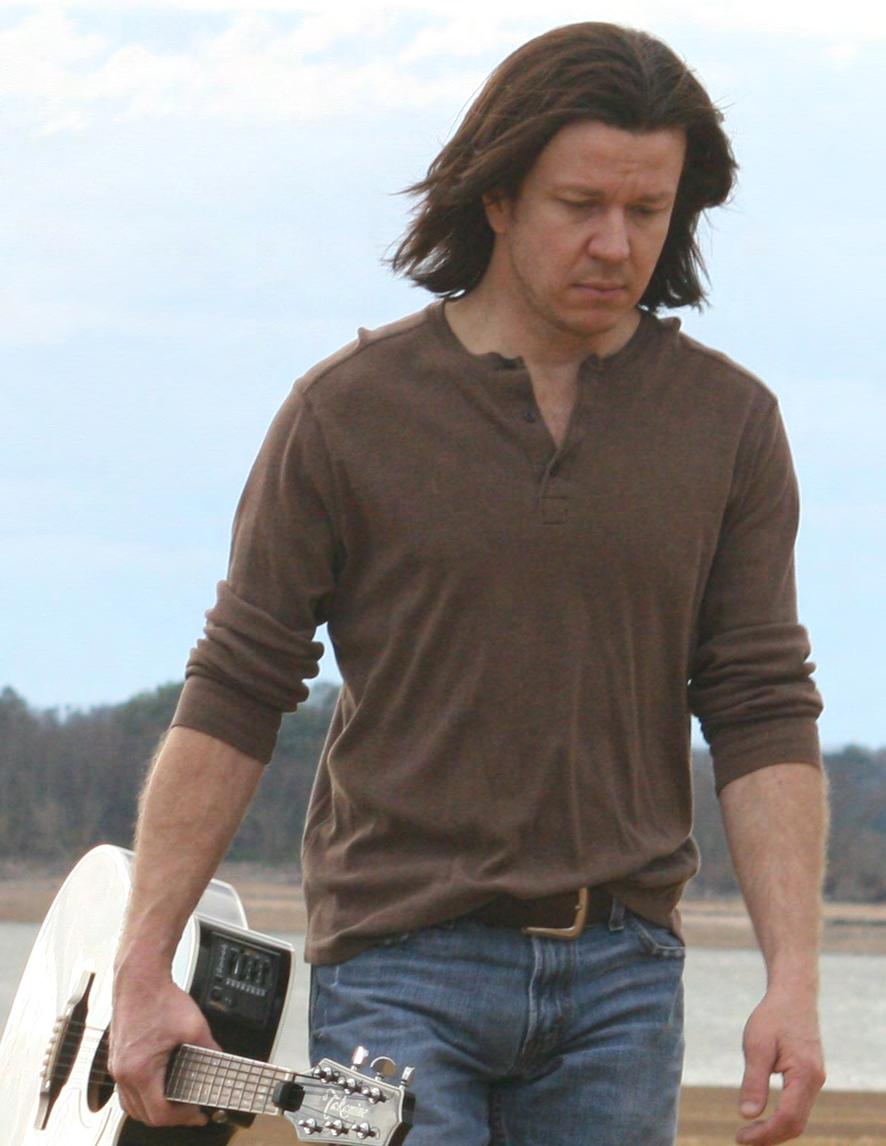
Part of the development of that project included work on a bluegrass song called “The Fall.” His sojourn into exploring bluegrass with that single song actually resulted in the spinoff bluegrassy companion album, American Cemetery. That one song appears on both releases.
“I was trying to explore genres I never explored before. I did this one bluegrass song...I just had so much
36
Martinez
Kara
Bachman
fun,” he recalled.
He played that first song for friends and family and said, “They were like…this makes me like bluegrass music!”
It inspired more; he continued in that vein and said the entirety of American Cemetery has a bluegrass vibe. Songs intended to be recorded as rock or country took on new life, perhaps relying on some of what he gleaned while growing up in southern Kentucky and listening to artists such as Ricky Skaggs, of whom he has always been a fan. He applied “traditional arrangements” to his “contemporary and sometimes quirky songwriting style.”
That record was recorded with backing band Chadwell Station, but Scott said most of his live shows – which happen primarily around his current home in eastern Tennessee, places such as Gatlinburg and Knoxville –are solo affairs.

He describes the studio rendition of the American Cemetery project in humorous terms.
“You could probably describe it [Chadwell Station] as the Steely Dan of bluegrass,” he laughed, likening it to the group known for its studio-only orientation. “It was kind of a studio band.”
More recently, Scott and Chadwell Station added another country/bluegrass record to the discography. “One Hillbilly Place” features six tracks of original music. Scott said, “At last count,” his music was on rotation at over 50 radio stations, at least that he is aware of.
An upcoming project is as unique as they come, with even more contrast and elements of the unexpected. He said it will be a collection of all-original music that’s “a real concept album,” as it will be an “80s New

37
Wave and Celtic amalgamation.” It will also contain features of Biblical history.
“I’m gonna take this 80s music and blend it with a more Appalachian sound,” he said.
Not content to restrict himself to one way of making music, he’s as interested in the influences of Duran Duran and Bryan Adams as he is in that of Johnny Cash and Ricky Skaggs.

“I like all those things,” he added, confessing he finds it “sad” when people limit themselves.
He’s been lucky. His love of music started when he was just a tiny kid, and he’s parlayed it into a way of making money and art. Through a story told often by his mother, he describes himself as a tiny tot absolutely enamored with music.
“It was back when a stereo was a piece of furniture, and you played records,” he said. When he was “two or three years old,” he would prop his chin atop the family stereo console and listen while watching the vinyl turn.

38
“I would go to sleep standing up, watching the records,” he said.
It wasn’t long before he penned his first song at age eight.
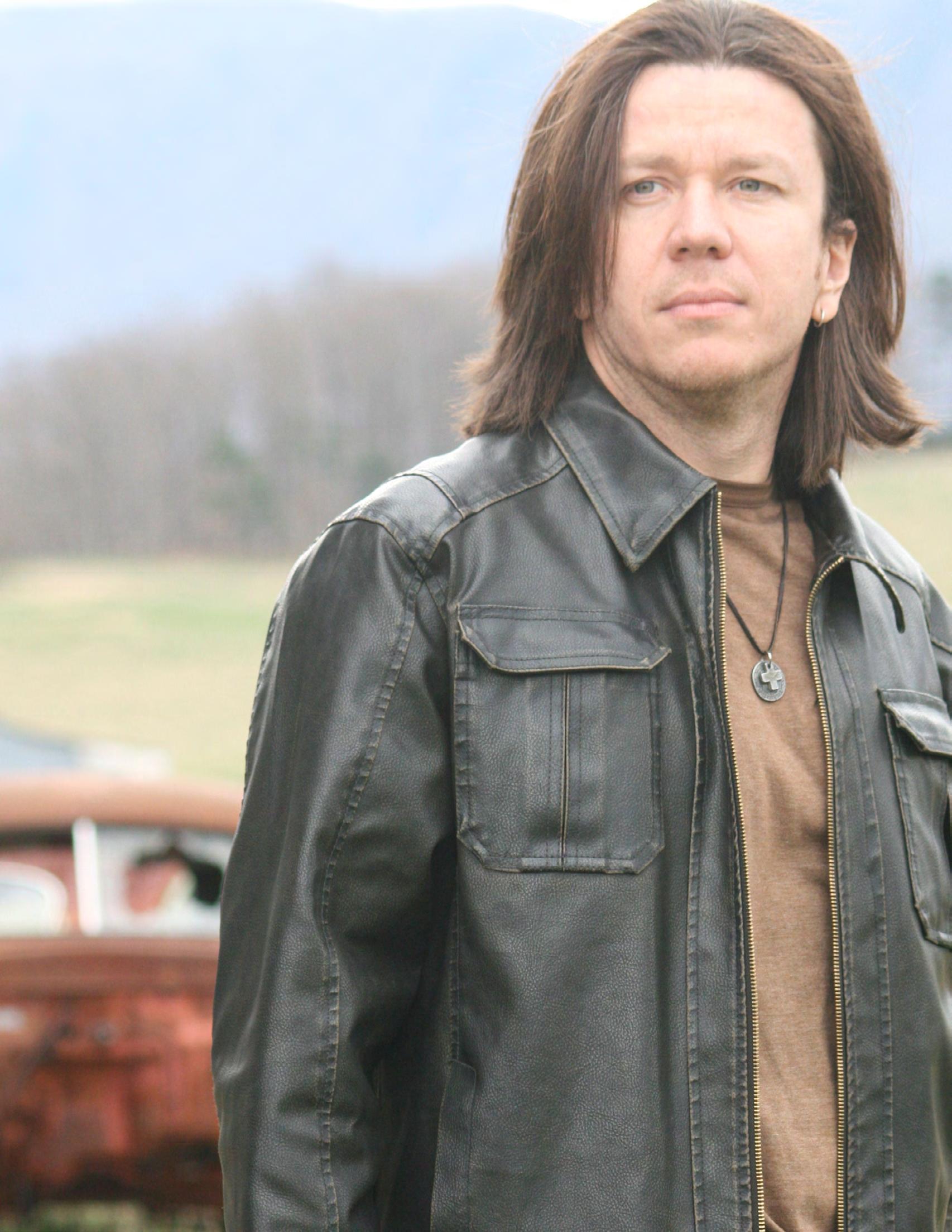
Today, he considers himself lucky to live a creative life over which he has complete control. It sounds like he loves it and where he is right now.
“I’ve made most of my living making music for a number of years,” he said. “Being able to make a living with your hobby…what could be better than that?”

39









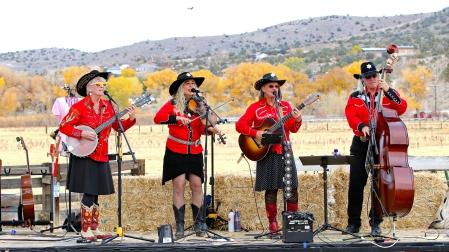

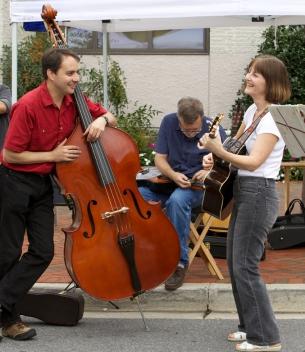

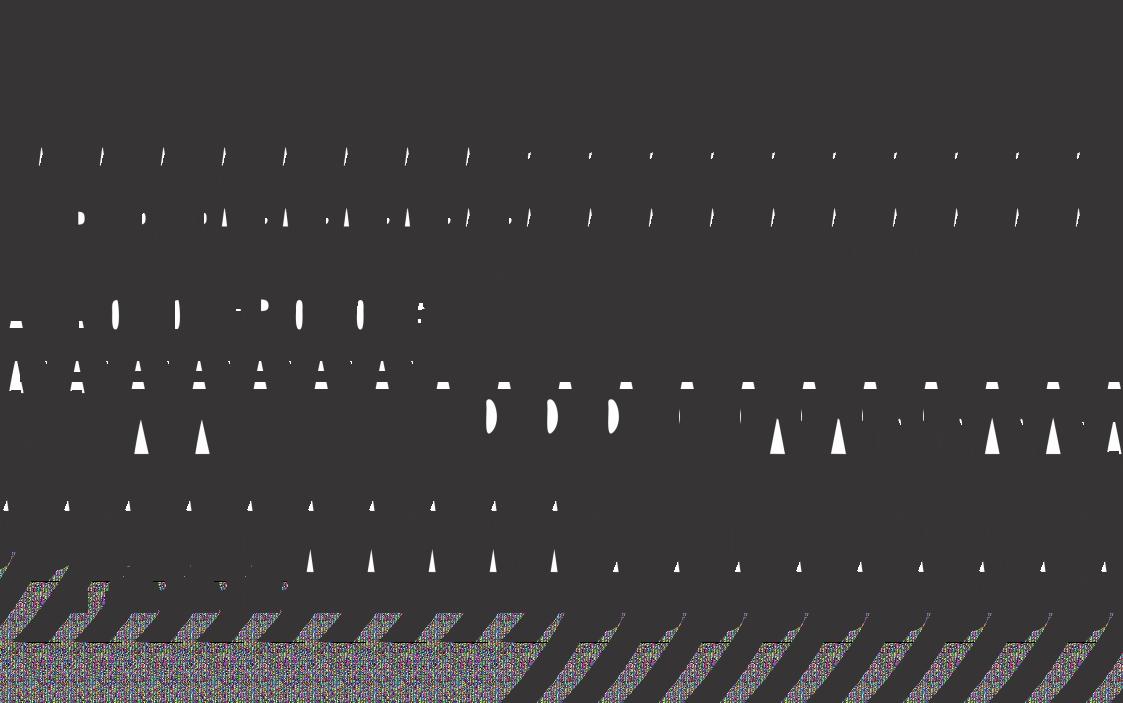

Saturday, September 2 Sunday, September 3 Come enjoy the free Open Mic Night on Friday, September 1 Live Gospel Service Sunday Morning BANANA AND THE BUNCH feat. Lowell Levinger of the Youngbloods SALTY SALLY DIRTY CELLO Wildcat Mountain Ramblers ets are only $50 for the whole weekend Cheap Tent and RV Camping too! LABOR DAY WEEKEND 2023 IN QUINCY, CA SQUARE DANCING IN THE MOUNTAINS Scan to buy tickets Tickets $50 Michael Haworth Lake Elsinore, California Dancing Friday evening, all day Saturday and Sunday morning Barbecue dinner included in package price Enjoy featured musical groups Pre-rounds Saturday evening, and rounds between tips Plus dancing focused on newly-graduated Plus dancers Sierra Sweethearts Front Porch Dust in My Coffee Silver City Sage Creek Ten Dollar Pony Lawrence Johnstone Sept. 1 & 3, 2023 Quincy, California Ukiah, California tickPurchaseyour ets&camping onlineat www.plumasamericana.com 40
SCOTT SLAY

41
Susan Marquez
Scott Slay was raised in a musical family. Growing up in Walnut Hill, Florida (a small farm town about 35 miles from Pensacola), he played in a bluegrass band with his dad. “When I was four or five, I told my dad I wanted a guitar. Instead, he bought me a mandolin.” By the time he was eight years old, Scott was playing in his dad’s band. “They needed a mandolin player, and I played the mandolin, so they threw me in. If I knew a song, I played it. If I didn’t know the song, I just chopped.” Scott recalls seeing Newgrass Revival at a private festival the Guthrie Trapp family put on. “I was blown away. I loved everything about it.”
Music was still important enough to Scott when he went to college, where he majored in jazz performance. But in his senior year of college, he changed his major to music education. It was the right move for Scott, who has taught music for the past eighteen years. “I moved to Virginia right out of college

and taught there for four years, then to D.C. for another three years before moving to Colorado to teach six years ago. Throughout his adult life, Scott has continued to enjoy playing bluegrass music.
In Virginia, he started a band called Scott Slay and The Rail. But it was during a spring break visit to Colorado six years ago that he found his current band members, now called Slay. “During my vacation to Colorado six years ago, I was hoping to find a bluegrass jam where I could play. I Googled ‘Bluegrass near me,’ and easily twenty to twentyfive distilleries near me popped up with bluegrass jams that night. I learned that there are local bluegrass gigs in the Denver area every day of the week.”
Scott went to a jam hosted by Jordan Ramsey, who has won multiple awards for his mandolin playing, including the 2008 RockyGrass Mandolin Competition and the 2016 National Mandolin Contest

42
in Winfield, Kansas. “Other than Jordan, everyone there was younger than me,” says Scott. “That really energized me because I saw a new generation of folks interested in bluegrass.”
Deciding that Colorado might be the right place to plant roots, Scott researched and found a school in the area that needed a music teacher. “I went to tour the school and interview for the job. After the interview, I was asked if I would accept the position.” Scott now teaches kindergarten through fifth grade in Arvada, Colorado. “I love it. When the bell rings at 3:00 pm, I’m finished for the day. That gives me time to work on my own music projects.”
Scott had already developed a substantial career in music. He started Scott Slay and The Rail in Virginia, and the band was featured at RockyGrass and Telluride Bluegrass Festivals in 2018. He was an artist-in-residence as part of Big Virginia Sky with Sammy Shelor, the frontman for the Lonesome River Band. They were invited to perform at the 2015 IBMA Wide Open Bluegrass Festival in North Carolina. Scott is accomplished on the guitar and mandolin, winning second place for each instrument in the
2018 RockyGrass Instrument competition and IBMA Guitar Player of the Year in 2021. While The Rail has released an album on the Bonfire label, Scott recently released a single, Mine All Mine, independently. “I wrote the song and played guitar and mandolin on the recording,” says Scott. He was joined on piano and vocals by Josh Shilling, frontman for Mountain Heart, along with Jeremy Garrett (Infamous Stringdusters) on fiddle and vocals and Aaron Ramsey (Volume Five) on bass. Fred Donovan produced the single.
Scott’s current band includes lead singer and guitarist Travis Stinson, Pete Weber on mandolin, Nick Einterz on banjo, Evan Gohring on bass, and Andy Reiner, known as “the skiing fiddler.”
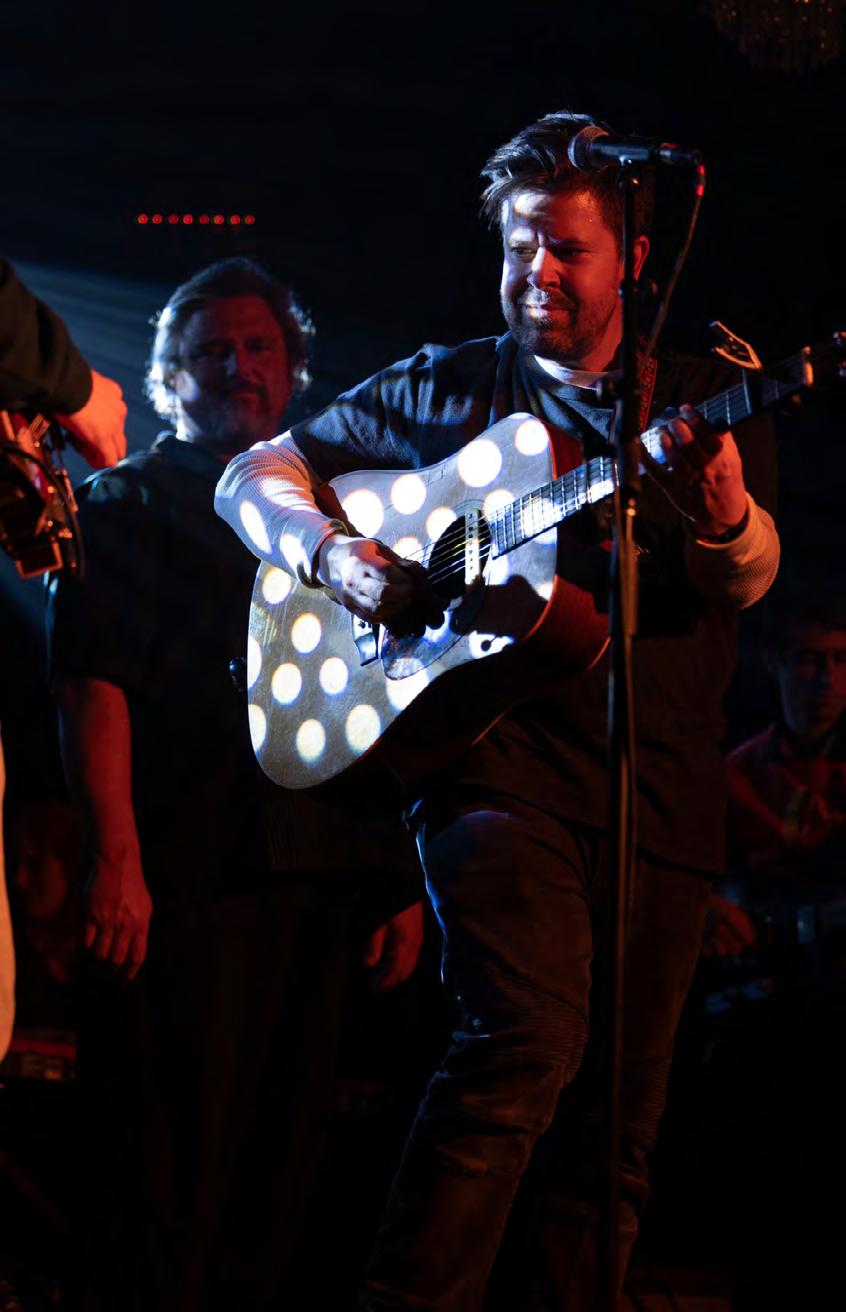

Scott says every band member is fully invested and committed to being their best. “We gather to rehearse every Monday. We also write together. I love to write, but no one can do it like Nick. He writes a song every day.”
When choosing a name for the band, the natural inclination was to revisit Scott Slay and The Rail. But Scott wanted a fresh approach to the music they were playing and a band name to reflect that. “Then, twice in one day, different people
43

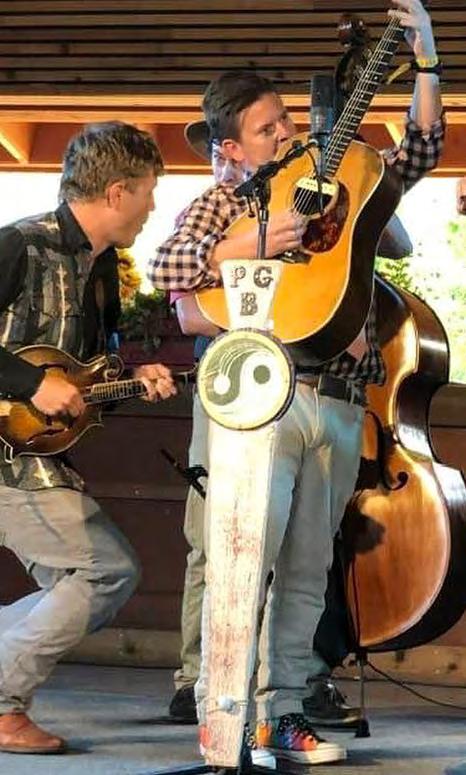
44
suggested that we call the band SLAY. I figured that was a sign, so we went with it.”
With influences such as The Punch Brothers, The Lonesome River Band, Mountain Heart, Nickel Creek, Dead & Company, Leftover Salmon, and Scott’s bluegrass hero, progressive pioneer Sam Bush, Slay offers a fusion of bluegrass, folk, traditional compositions and country with songs that reflect both real and imagined life experiences. “We are trying to create a real original product.”
Scott says the band is working on recording now. “We are looking forward to playing at the Telluride Bluegrass Festival in September. It’s such a great festival and a wonderful opportunity to get the attention of other festival promoters, especially in Colorado.”


45
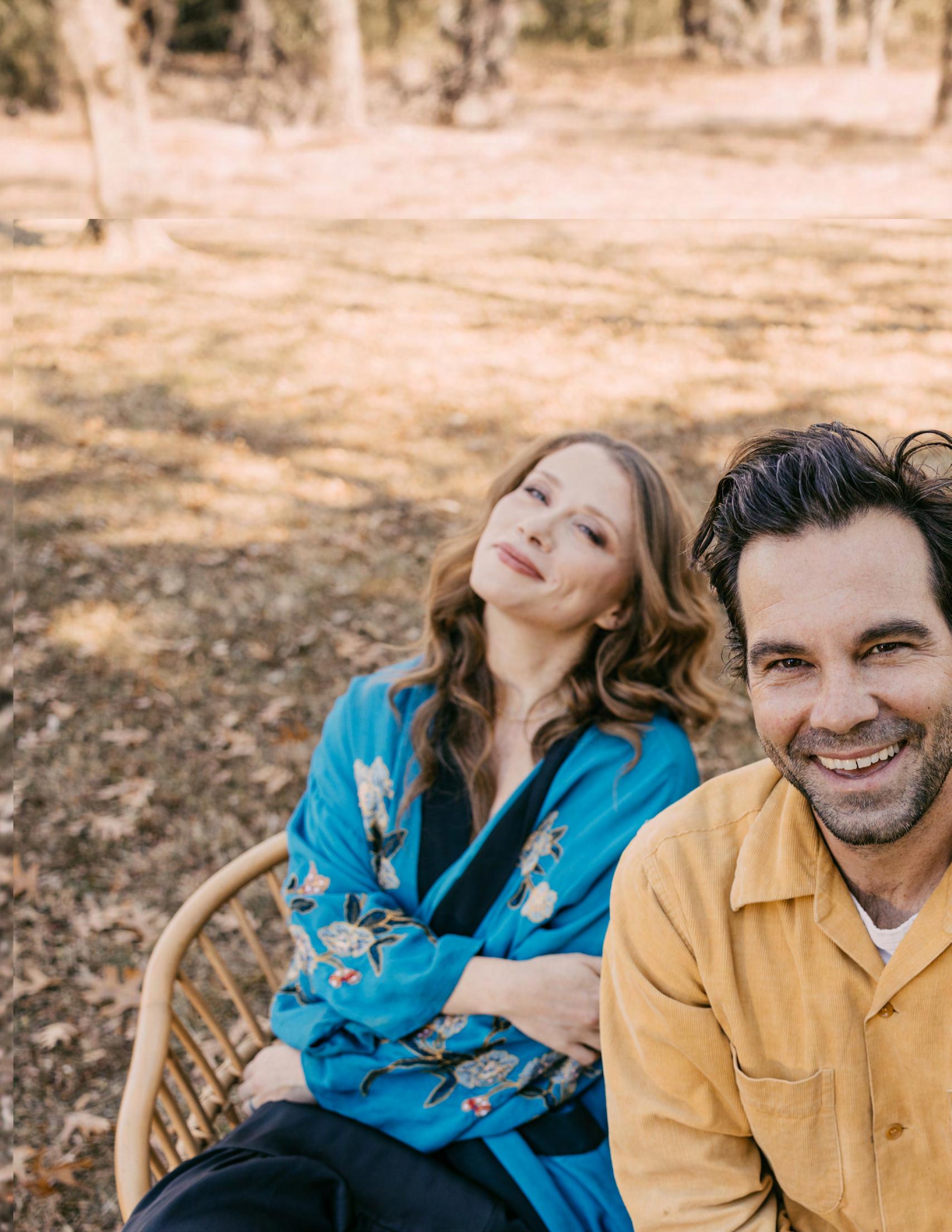

46

 Kara Martinez Bachman
Kara Martinez Bachman
47
Photo: Eric Ryan Anderson
Trying to put The Lone Bellow into a restrictive little box would be about as effective as trying to grasp a handful of water or telling a sound exactly what it’s supposed to mean and expecting it to abide.
Most will place this trio into the Americana genre, where varied roots expressions are embraced. What this Brooklyn-formed but now Nashville-based outfit delivers year after year is so multifaceted, though, any pigeon-hole feels like some unfair diminishment.
From one song to the next—or one moment to the next—you’ll hear rousing, tight gospel harmonies; bluesy country; straight-up folk; indie rock; and, more recently, a lean into a mellow pop orientation, at least with the studio versions of their newest music.
Their first album appeared at #64 on the Billboard 200. People magazine selected that record as #8 in its top 10 albums of 2013, and Entertainment Weekly heralded it as one of the “top reasons to love country music in 2013.” In the decade since, The Lone Bellow has toured with performers such as Kacey Musgrave, has received consistently high rankings for singles on Billboard’s AAA (Adult Alternative Airplay) charts, and has been nominated by the Americana Music Association for Duo/Group of the Year.
The Lone Bellow is currently touring the U.S. in support of its fifth album, the November 2022 release, Love Songs for Losers. The group offers meaningful songwriting and a musicality that’s at its best when witnessed live, where listeners can fully appreciate the trio’s visceral connection to the music and one another. The three bandmates – Zach Williams, Brian Elmquist and Kanene Donehey Pipkin – sometimes seem to communicate with each other onstage as if they were a single organic unit, sharing a common fervor for something deeply-felt. For this tour, they’re fully unplugged, grouped around a single microphone and creating harmonies capable of eliciting misty eyes and spinetingling frisson. Their voices feel huge, and that immense simplicity is no less than compelling.
While it is admittedly more difficult for an act to market itself when refusing tight definitions, maybe searching too hard for that would clip their wings. The band itself (thankfully) does not clear it up all that much.
“It’s basically trying to pull these different influences in, but make it sound like it came out of the ground,” said The Lone Bellow vocalist, guitarist and songwriter Brian Elmquist. His early background in music didn’t come from a place of tradition, but like all good musicians, he evolved.

“I was in, like, punk bands when I lived in Nashville,” he said. “I would only write country songs as an exercise before I moved to New York.”

48

49
Photo: Eric Ryan Anderson
There, he and Pipkin came on board with lead vocalist Williams, who had at that time been performing as a solo act.
“Maybe because New York is just like a concrete jungle of technology…we just wanted to unplug a little bit.”
That “unplug” seems to have included a big “plugin” to bluesy gospel harmonies.
“We all were raised up in church,” Elmquist explained. “Zach [Williams] grew up in a big ole Baptist church in Atlanta. But…you don’t have to be religious to feel this stuff.”
The lyrics don’t usually reference Christian themes…
but the feeling of something deep-down and spiritual is there, for sure.
“We need more than ever to figure out how to connect to our soul,” Elmquist said. “Some of our fans call us ‘church for heathens,’... and I love that because I feel like that is it.” He said the ‘spiritual’ side of the music is inspired by the primacy of his family and friends. It sounds as if he loves the fact that they’ve been able to tap into a reservoir of harmonic emotion that’s usually the purview of a more strict religious paradigm.
“It’s an insane privilege, and we don’t take it lightly,” he said, of the fact that fans connect so much to the church of The Lone Bellow.
“I see us trying to connect with humanity, still

50
trying to find the common thread, and still trying to push to new limits,” Elmquist said of their future goals. The implication is that they strive to be as genuine as possible and hope it has meaning to listeners.
“People who are 100-percent themselves…everybody can identify with it,” he added.
Elmquist zeroed in on the reason The Lone Bellow seems so heartfelt. Perhaps, it’s because it really, really is.

“You can’t make art and worry about the outcome,” he summarized.
They went their own way for Love Songs for Losers, producing this record themselves.
“We found Roy Orbison’s old pool house and turned it into a studio for eight weeks,” Elmquist said about where it all happened.
“We’ve worked with some incredible producers [in the past], so we got to be in the room to see how the sausage is made,” he said. For previous records, they’d worked with notable producers such as Aaron Dessner of The National, and eight-time Grammy Award-winner, Dave Cobb.
This time, they wanted to take a dive into deeper, more risky waters.
“We’ve always done better when we’re kind of on the edge of the sound people are expecting,” he said. “You want to make records where your chin is in the water, where it’s almost dangerous.”
51
Photo: Eric Ryan Anderson
Talisk

52
It’s hard to believe that three people, with three instruments, can create the sound and energy presented at a Talisk concert. Using only a fuse concertina, a guitar and a fiddle, the three musicians in the band bring a depth that keeps audiences mesmerized. Their multi-layered signature sound makes them one of the most in-demand folkbased groups to come out of Scotland in the last decade.
Mohsen Amini, an Anglo-Iranian musical prodigy, founded the trio in Glasgow in 2014. The original members were Mohsen on concertina, guitarist Craig Irving, and fiddler Hayley Keenan. “It was supposed to be a one-time gig,” he says. But the band’s chemistry and unique sound was undeniable.
Talisk won the Danny Kyle Award at Celtic Connections two months after their formation. Their self-released debut album, Abyss, was shortlisted at the MG Alba Trad Awards as Album of the Year in 2016, the same award that Talisk named the 2017 Band of the Year.


The band began touring Europe, and audiences responded well to the high-energy performances of songs that were modern, accessible, and somewhat faintly pop-oriented. Soon they were touring internationally, playing at some of the world’s largest festivals.
Craig and Hayley eventually left Talisk to pursue personal projects. Current Talisk members include Mohsen, Graeme Armstrong, and
53
Susan Marquez
Benedict Morris. The three band members are more than musicians. They have been described as “three master craftsmen with one unmistakable, bold sound and captivating live show.” The instrument Mohsen plays is an unusual one.
“I played the concertina because no one else wanted it,” he recalls. “I took lessons in Scotland and have been playing it for twenty years now.” Mohsen makes the concertina hip, and it’s hard to take your eyes off him when he plays it. While he did not grow up in a musical family, Mohsen says his family took him and his siblings to Irish dance classes.
Benedict is the group’s fiddle player. He grew up in an arts organization in Scotland. “I


also had some music in my extended family, particularly the fiddle. I got into classical music and studied privately with a violin teacher. I attended the Royal Conservatory’s Saturday classes for six years.” All in with classical music, Benedict studied classical violin at university. His talent was recognized early on when he won the BBC Radio Scotland Young Traditional Musician of the Year, and he has made numerous television appearances. “I grew up listening to great bands but have always used classical music to inform my musical aesthetic.”
Graeme Armstrong rounds out the group on guitar. “I always liked the guitar,” he says. “I really liked Jimi Hendrix when I was younger
but I also enjoyed national and traditional music. It seems that I was always surrounded by music when I was growing up, mostly in pubs.”
Talisk has played around the world. “We have found there are ex-pats all over the world, and because of that, we have been generally well-received wherever we go,” Mohsen says. There is no singing. While the performances are acoustic, the music is enhanced with synthesizer and electric guitar recordings. Mohsen describes the band’s music as ‘Celtic punk’; however, he says he resists putting the band in a box. “Nowadays, bands aren’t described by one genre.” He cites Hans Zimmer and Ludovico Einaudi as his main musical
54
influences. Talisk is probably best categorized as alternative folk.
The band released their next album, Beyond, in 2018. Experimenting with a different sound, the album has a tranquil feel - a sort of pensiveness not heard on the first album. They released a single, “Aura,” in July 2021; in February 2022, they released their third album, Dawn.

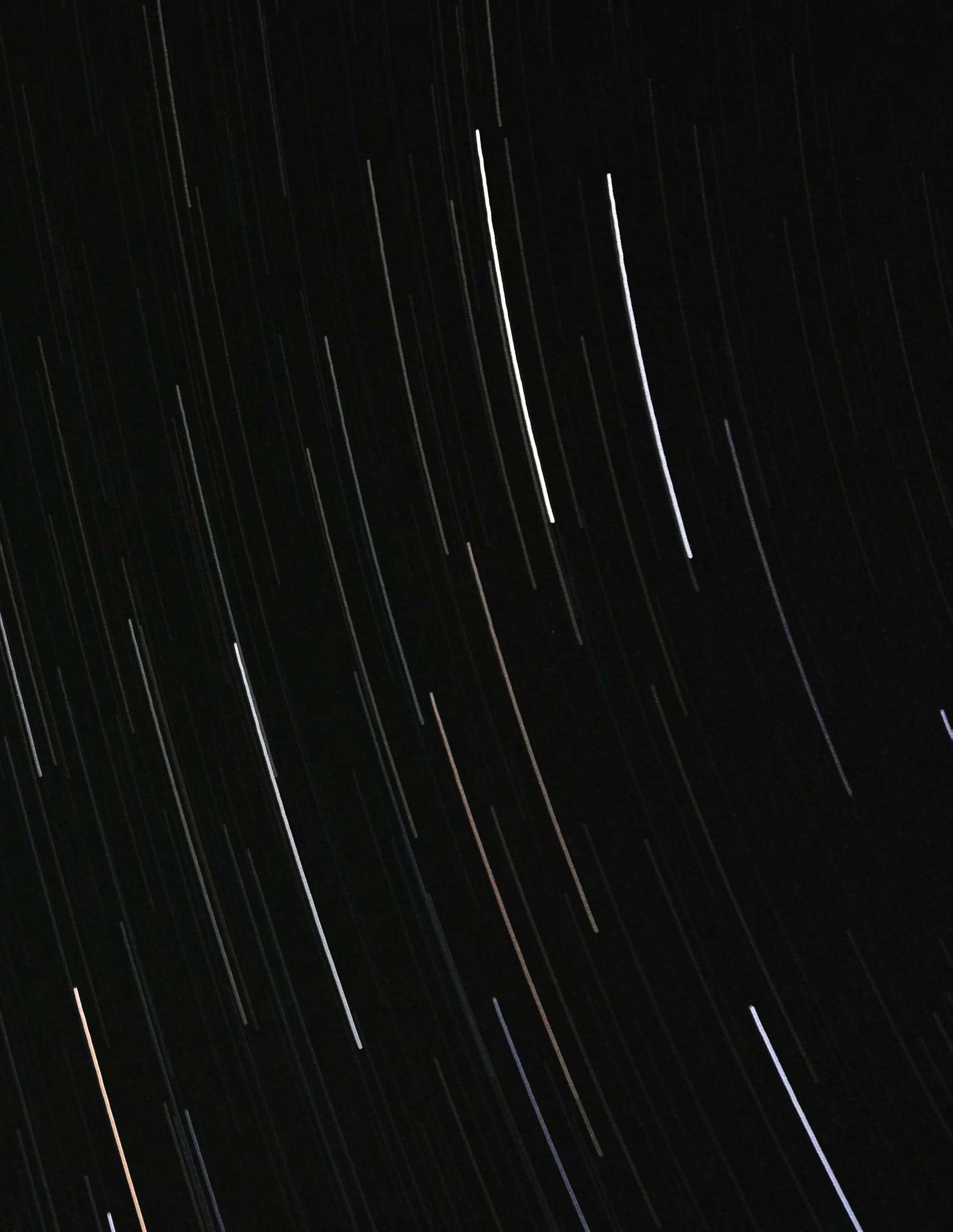
After completing a United States tour in early spring, Talisk returned to Scotland, where they toured the U.K., Spain and France. “Our first trip to America was to play at the Folk Alliance International conference five years ago,” Mohsen says. “We loved it and hope to do more tours in the United States.”
Benedict states that he feels very fortunate to play music that is well-received by audiences around the world. “We just continue to grow and grow,” he says. Mohsen adds, “We continue to pay attention to what works on stage. We kind of feel that our first two albums were practice. We have written a lot of music since Covid, and we have a lot of exciting things in store.” The energy is there, and the high-decibel volume encourages plenty of foot-stomping during their concerts. A Talisk concert is anything but tame.
55
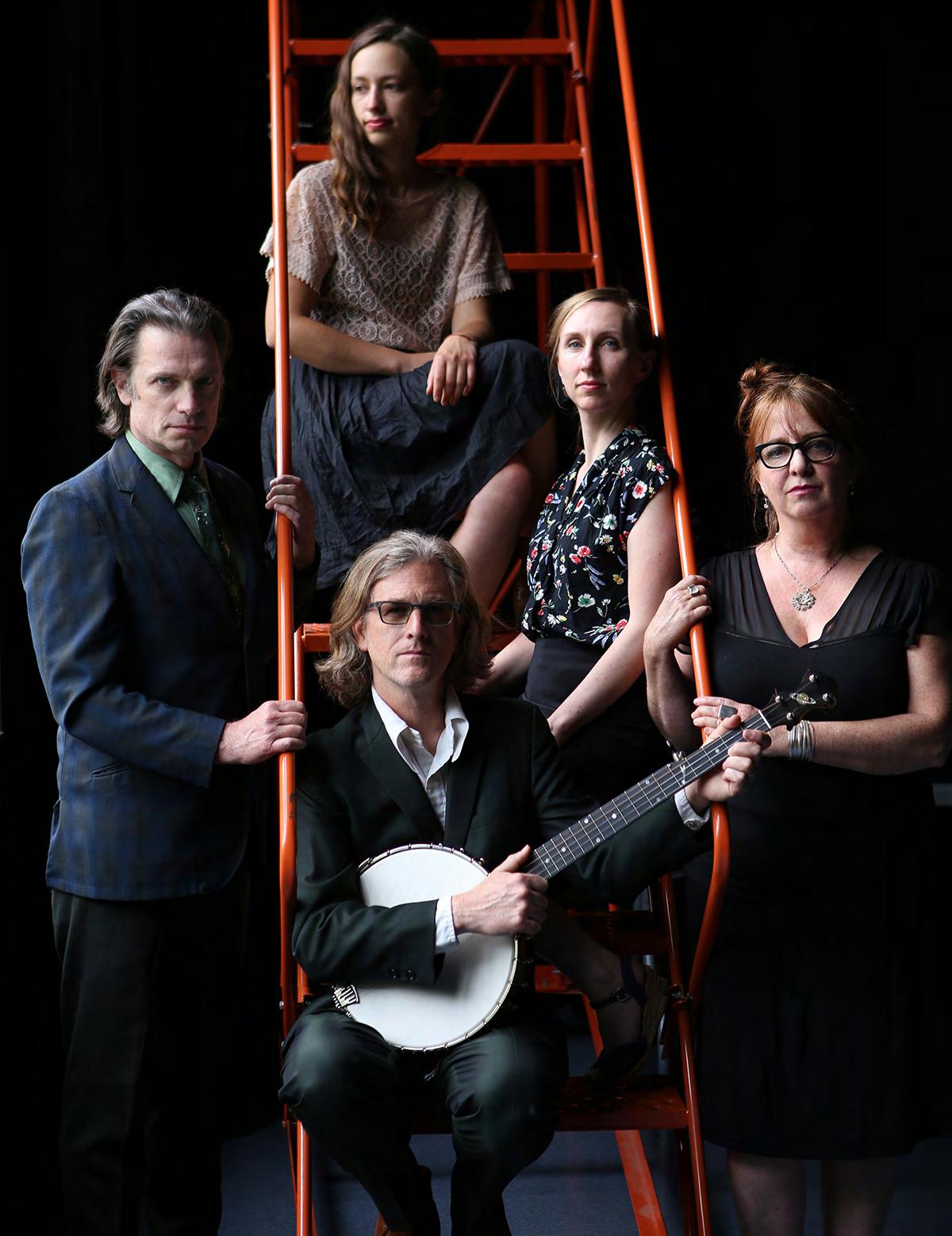
Kara Martinez Bachman
The Crooked Jades
The Crooked Jades have created a unique sound to “re-imagine” old-time music for today’s listeners. It’s gritty and real. Dark, even. The band’s old-time instruments combine with a unique aesthetic and crossgenre pollination that’s exceedingly rare. While the greats of American roots music influence them, the mood is just as informed by the half-rough, half-ethereal worlds of goth, darkwave, and the deeper parts of 1980s post-punk. Strange bedfellows, indeed, for an old-time outfit.
It’s a unique testament to commonalities, both of the past—for instance, the late 19th century or the Depression Era—and the sonic milieu that shaped the band members’ youth—these times brought forth art that explored fear, alienation, and longing. The relentless artistic drive to capture both the horrors and beauty of those eras was sated in genres that might initially seem a huge contrast but share a common emotional core.
“My very early influences from childhood were steeped in old-time and folk music,” explained Jeff Kazor of the Crooked Jades. “But once I got to high school and college, I was exposed to so many different genres of music, including the alternative music scene of goth, darkwave and post-punk.”
Kazor saw that the music of his earliest years wasn’t actually all that different from cutting-edge trends happening in alternative scenes of the 80s and early 90s.
“There is a raw, dark underbelly infused in American traditional roots music that gave me more in common with – and connection to – contemporary artists such as Nick Cave and the Bad Seeds and Tom Waits,” he said. “These bands are still huge influences on my musicality, including their powerful and emotive live shows, which ended up influencing my approach to arranging and performing traditional music.”
At first, the band was taking a risk with a sound that was so…unexpected.
“In the beginning, The Crooked Jades’ theatrical presentation of old-time music was unconventional in the traditional circles and was not received very well,” he confessed. “But as years went by, I felt the criticism became our strength, and indeed, helped us build a wider audience for our music and sound by exposing new listeners to old-time music and traditionalists to some new interpretation and approaches to playing old-time.”
The San Francisco-based band’s most recent album, “Empathy Moves the Water,” features 13 tracks, some of which use unexpected instruments such as the Vietnamese jaw harp and the harmonium.
“This album reflects what is going on in our community, country and world,” Kazor explained. “There is so much fear-based behavior today that devalues empathy, and it is compromising our humanity. We’re reflecting on how humans, living things and Mother Earth are mostly water. Water is what connects us, moves through us, and gives us life.”
“I would argue that empathy is an essential life force, like water, and without empathy, we stagnate,” he continued. “There are so many religious themes around water – cleansing, rebirth and life – and the inconvenience of humanity in a modern world of automation. We are calling out to the great empathy spirit
57
for salvation!”
For Kazor, the album’s cover art perfectly relays the meaning behind the record.
“The imagery of the album cover somehow captures empathy for me…releasing empathy into this world without discrimination,” he explained.
Music of The Crooked Jades has been used in films before, and another project is coming up soon.
“Our music is featured in a soon-to-be-released film, ‘Call Me Mule,’ by award-winning documentary filmmaker John McDonald,” Kazor said. “The Crooked Jades composed and provided music for the featurelength documentary and is expected to have a summer release.
The project, filmed over a 27-month period, is the story of one man’s struggle to roam freely with his mules, seeking a balance between the manmade world and the natural world.”

58
“The film raises issues that concern all of us,” he continued. “Preserving open space, individual freedom of movement, access to public land, and the system’s treatment of people living outside society’s norms.” He added, “We love the film and are honored to participate in this amazing project.”
Kazor said the band is currently in pre-production and “is looking for financial backing” for a new project.
“This new album will draw some unexpected connections between the 1880s and 1980s,” Kazor said. “It will be an album of 1980s obscure goth and darkwave songs, all interpreted on fiddle, banjo, slide guitar, ukulele and arco bass.”
For some, it might be hard to reconcile how the 1980s alternative could have so gripped someone who grew up exposed to the greats of traditional music. Those who know both genres well, however, will “get it.”
“In 1977, My dad took me to my first concert at the Santa Cruz Civic to see Doc and Merle Watson accompanied by Merle’s super musician hippy friends,” Kazor recalled. “What an amazing performance!”
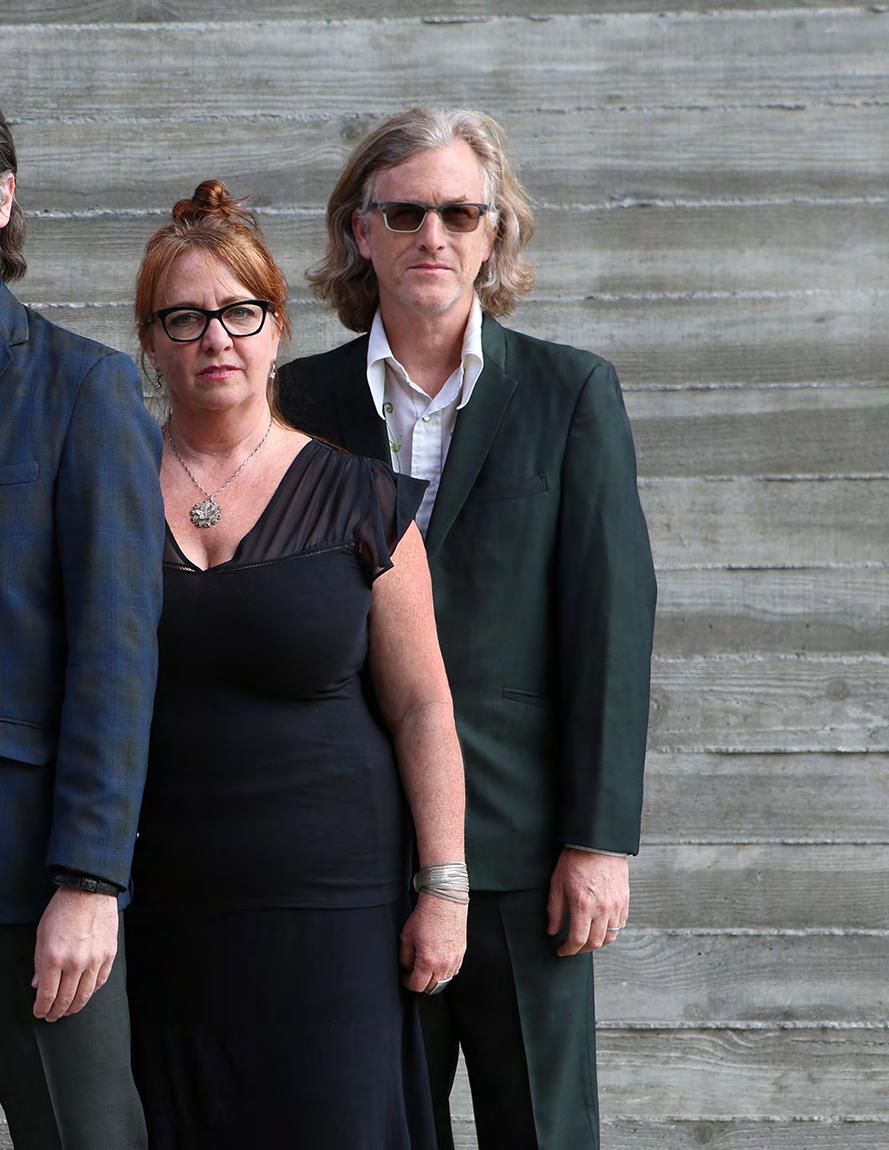
59

60
“Little did I know this event would be life-changing,” he continued, “leading me to what proved to be my biggest influence, the Folkways album, ‘The Watson Family.’ Its essence was a primitive mountain music sound that appealed to me because it couldn’t really be categorized. It was all over the map and blurred the edges between genres. That concert sparked my desire to study and play American folk music.”
“It was the genesis of my music-making pursuits,” he said, “and the formation of The Crooked Jades, which has been playing and evolving for over 25 years.”

61
Discover
Appalachian Communities Through Food Markets
Food can bring people together. And when it’s in abundance at a local marketplace, food can be the center of the community.
Many major cities have marketplaces full of organic groceries and restaurants, like Park Place Market in Seattle or the French Market in New Orleans.

Appalachia, too, has its own marketplaces - which offer an inside look at the foods that are central to the community. From canned goods and fresh eggs to pickled vegetables and spice mixes, the foods found in these community markets help tell the story of the people.
1. Capitol Market
800 Smith Street
Charleston, West Virginia
This year-round market is tucked into a turn-of-the-century train station that features both indoor and outdoor spaces. Inside, you’ll find specialty shops that feature handcrafted chocolates, local coffee, handrolled sushi, a high-end wine shop, fresh seafood, a sit-down Italian restaurant and more. Outside, you’ll find seasonal produce and plants from local farmers, including Christmas trees in the winter, hanging baskets full of flowers in the spring and homegrown tomatoes all summer long. The Capitol Market is open Monday through Saturday from 10 a.m. to 6 p.m. and Sunday from noon to 5 p.m. For more information, visit https://capitolmarket.net/.
Nelson 62
Candace
2. Pittsburgh Strip District
Between 11th Street and 33rd Street, from the river to Liberty Avenue
Pittsburgh, Pennsylvania
The Pittsburgh Strip District is more than a marketplace - it’s an entire neighborhood full of international restaurants, produce merchants, grocery stores, hot food vendors and boutique shops. The area previously served as an industrial center with mills and other production shops before the industry decline. Now, you’ll find streets lined with vendors selling everything from pierogies and pepperoni rolls to pasta and cheese. Don’t forget a stop at the famous Pennsylvania Macaroni Company - or Penn Mac - to purchase all your Italian provisions. Hours for individual vendors and stores vary. For more information, visit https://www. visitpittsburgh.com/neighborhoods/strip-district/.
3. Chattanooga Market
1829 Carter Street
Chattanooga, Tennessee
Since its opening in 2001, Chattanooga Market has named one of the “Top 10 Public Markets in America” by Frommers. The seasonal Sunday market features over 50 farms, which sell a variety of meats, produce and dairy. In addition, there are over 130 artisans offering their arts and crafts, like hand-blown glass, paintings and more. The market is held April through November on Saturdays from 11 a.m. to 4 p.m. For more information, visit https://chattanoogamarket.com/.
4. The S&W Market
56 Patton Avenue
Asheville, North Carolina
Ranked as one of “The 10 Best New Food Halls Across the U.S.” by Fodors, The S&W Market in Asheville showcases the region’s local independent restaurants and beer in a 10,000-square-foot space. “Originally built for the S & W Cafeteria in 1929, the reimagined food hall fulfills the market’s original mission by offering affordable, fresh fare, and the energy that made it an exciting destination so many years ago,” the website reads. The food hall features five food stalls, Highland Brewing downtown taproom, event venue and more than 170 interior seats and an outdoor patio. This market focuses on prepared foods and features items central to the food culture of the region: buttermilk fried chicken, pimento cheese, sweet pickle relish, local honey and more. The S&W Market is open Monday and Tuesday from 11:30 a.m. to 8 p.m.; Wednesday, it is closed; Thursday from 11:30 a.m. to 8 p.m.; Friday and Saturday from 11:30 a.m. to 10 p.m.; and Sunday from 11:30 a.m. to 7 p.m. For more information, visit https://swmarketavl.com/.

5. Pizitz Food Hall
120 19th Street North
Birmingham, Alabama
Birmingham, Alabama, is one of the largest cities in the Appalachian region and contains a diverse assortment of offerings at the Pizitz Food Hall - from an Ethiopian restaurant and Mexican paletas made with local produce to Japanese-Hawaiian poke bowls and Israeli falafels and kebabs. The 30,000-squarefoot-space full of 18 different stalls also offers comfort food items, like waffles, fried bologna biscuits and local coffee. Plus, the food Hall also featured a bar, soda fountain and independent movie theater. The Pizitz Food Hall is open Monday through Saturday from 11 a.m. to 8 p.m. For more information, visit https:// www.thepizitz.com/food-hall.
63




64
Notable Nearby Markets:
While these markets are located in states that have areas within Appalachia, they are just outside of the general region. Despite that, they still serve Appalachian communities nearby:
West Side Market in Cleveland, Ohio

Ponce City Market in Atlanta, Georgia
Charleston City Market in Charleston, South Carolina
Findlay Market in Cincinnati, Ohio
Krog Street Market in Atlanta, Georgia
Nashville Farmers Market in Nashville, Tennessee

Reading Terminal Market in Philadelphia, Pennsylvania
Markets - whether offering fresh produce or freshly prepared meals - offer insight into the foods important to communities. From global influences combined with local flavors, the food represents the communities and helps tell a piece of their story. Many market spaces carry both new and cherished foods that will satisfy consumer demand. And with each bite, not only are customers contributing to the local economy, but they are consuming a piece of culture, as well.
65
FAN PHOTOS

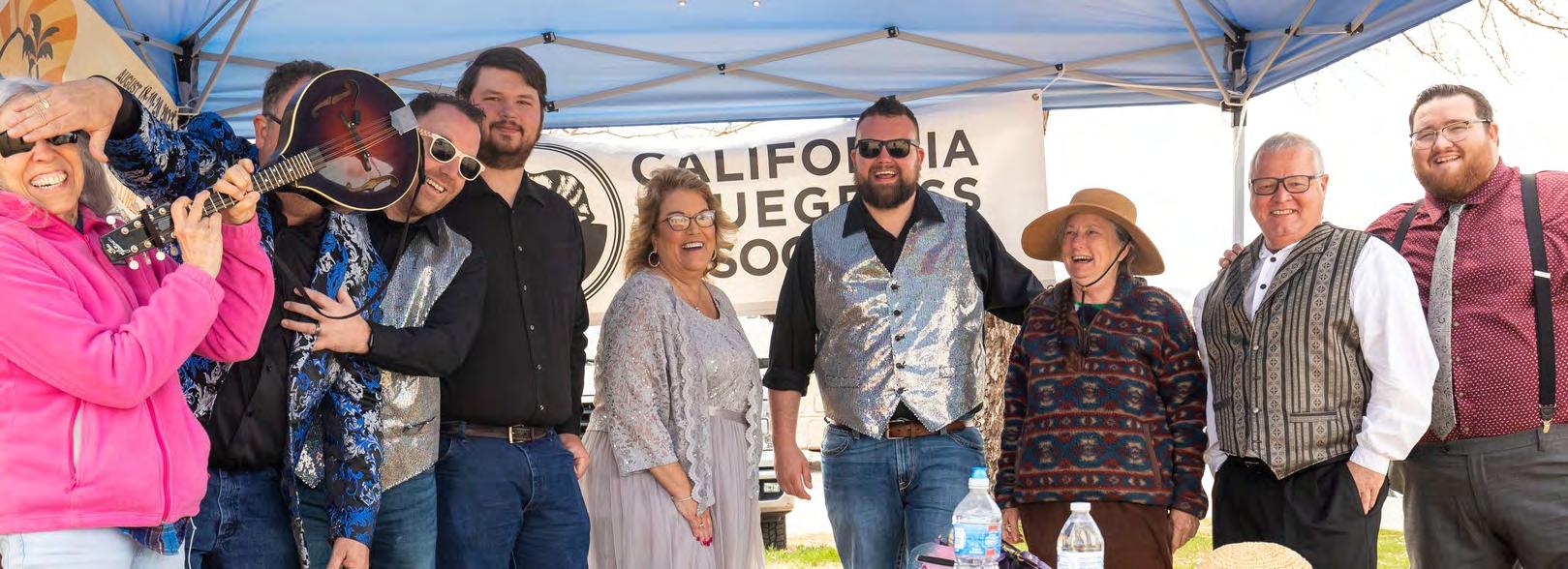
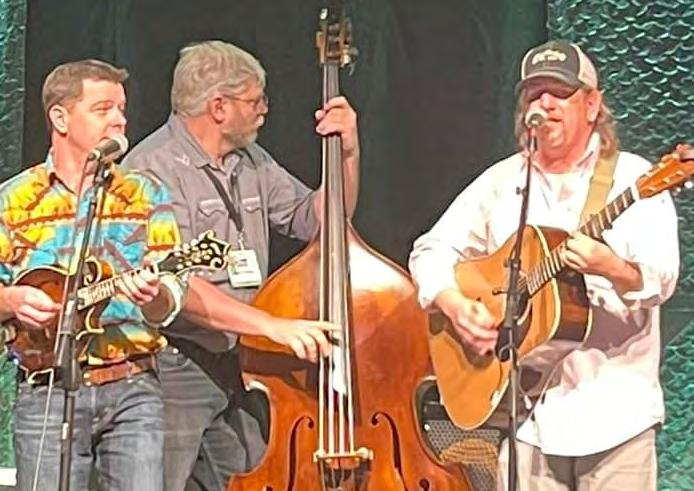

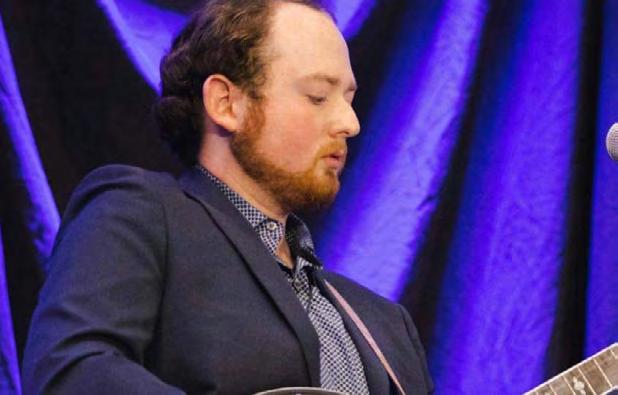



66

67





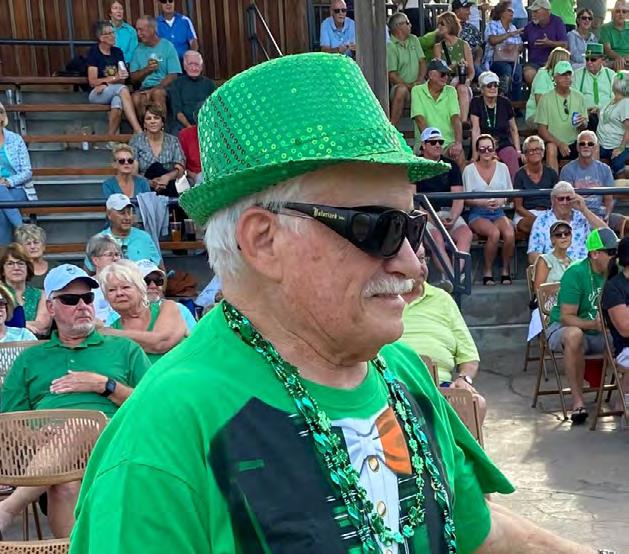
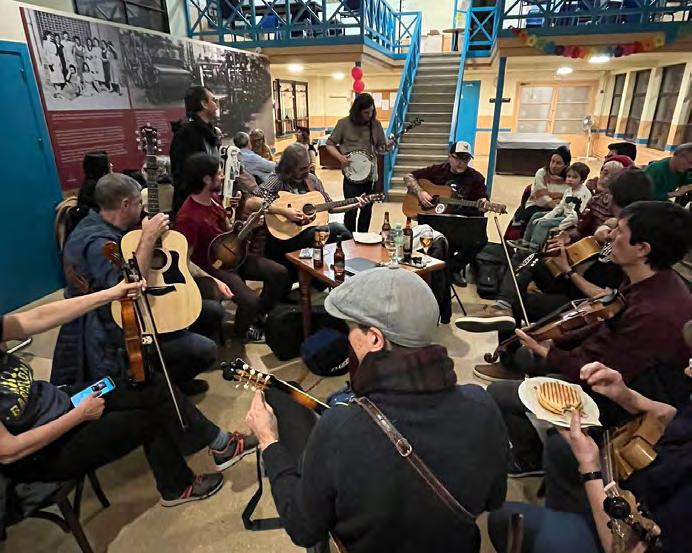

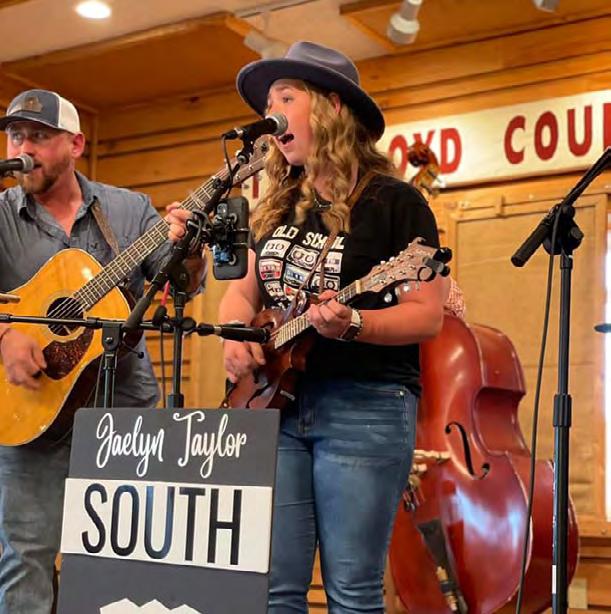

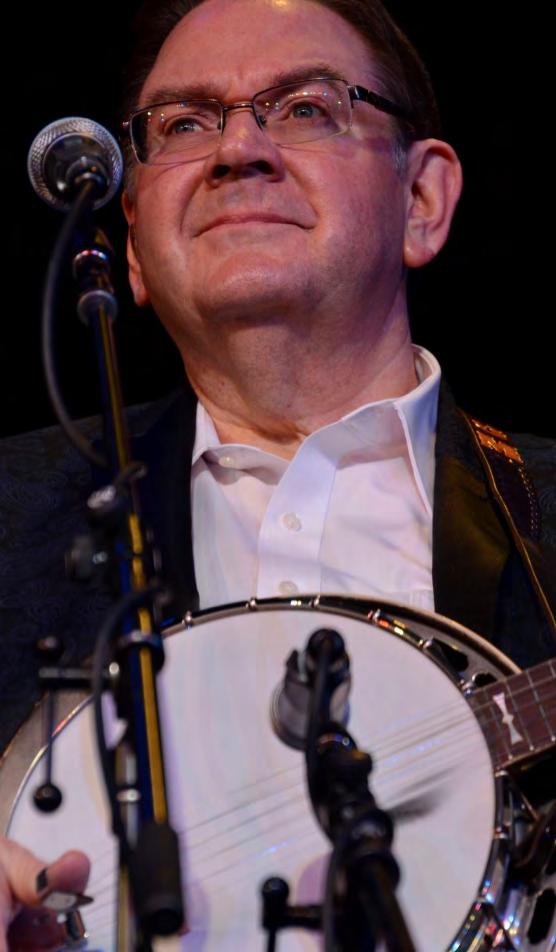
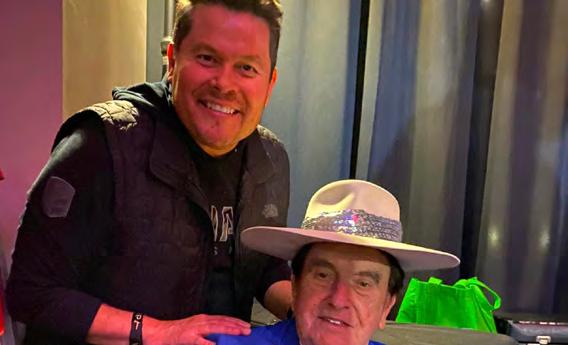


68
Georgia Mountain Fairgrounds Presents:



The very best in Country, Bluegrass and Gospel! Country Gospel Bluegrass



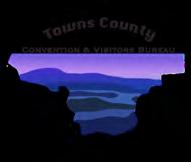




RV camping RV camping is available by the lake with full hookups and amenities. is available by the lake with full hookups and amenities.
3-day passes and single day 3-day passes and single day tickets are available. tickets are available. Prices range from $75 - $225. Prices range from $75 - $225.



Camping Concerts Events Gardens
P u r c h a s e t i c k e t s a t G e o r g i a M o u n t a i n F a i r g r o u n d s . c o m -1pm - VIP Acc m - Bellamy Br pm - Dailey & V m - Nitty Gritty D Saturday, September 16 Saturday, September 16 12pm-1pm - VIP Access 4pm-5pm - Gene Watson 6pm-7:30pm - Dailey & Vincent 8pm-9:30pm - Tracy Lawrence 4pm-5pm -Malpass Brothers 6pm-7:30pm - Rhonda Vincent 8pm-9:30pm - Daily & Vincent Friday, September 15 Friday, September 15 Thursday, September 14 Thursday, September 14
Hwy 76 West | Hiawassee, Ga | 706-896-4191 69





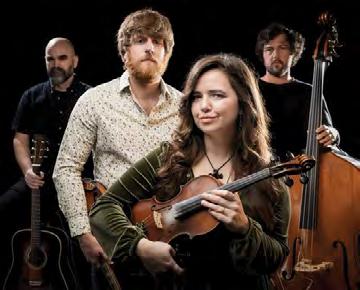


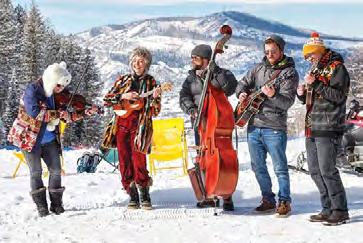

AdvanceTickets OnSaleNow! Call 620-221-3250 or Locate everything Walnut Valley Festival at www.wvfest.com P. O. Box 245 Winfield, KS 67156 Rob Ickes & Trey Hensley Sadie Gustafson-Zook ♪ 24-Hour Jammin’ ♪ Camping ♪ NewSong Showcase ♪ Acoustic Kids ♪ PreFest Workshops ♪ Feisty Kids Camp ♪ Arts & Crafts Show RUNA The Barefoot Movement Appalachian Road Show Haymakers 8 Instrument Championships +Morethan$113,000 inPrizes 70



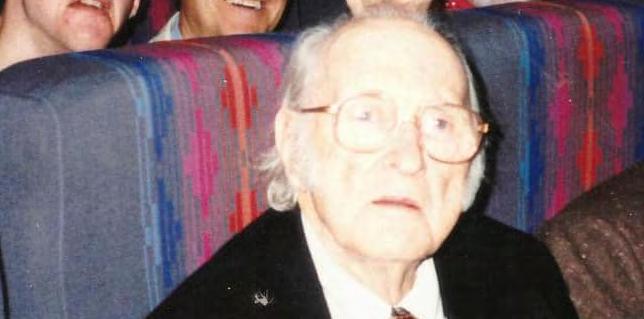


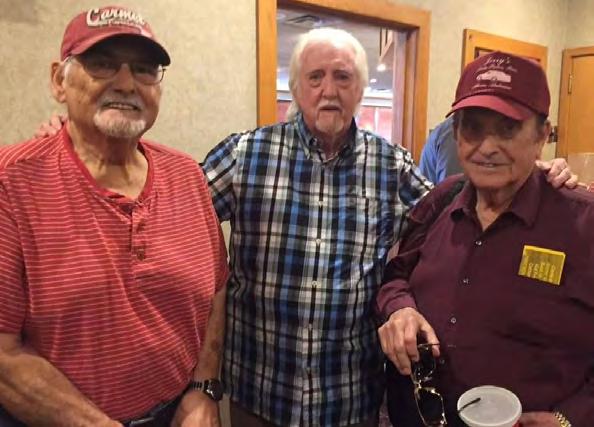


71

72
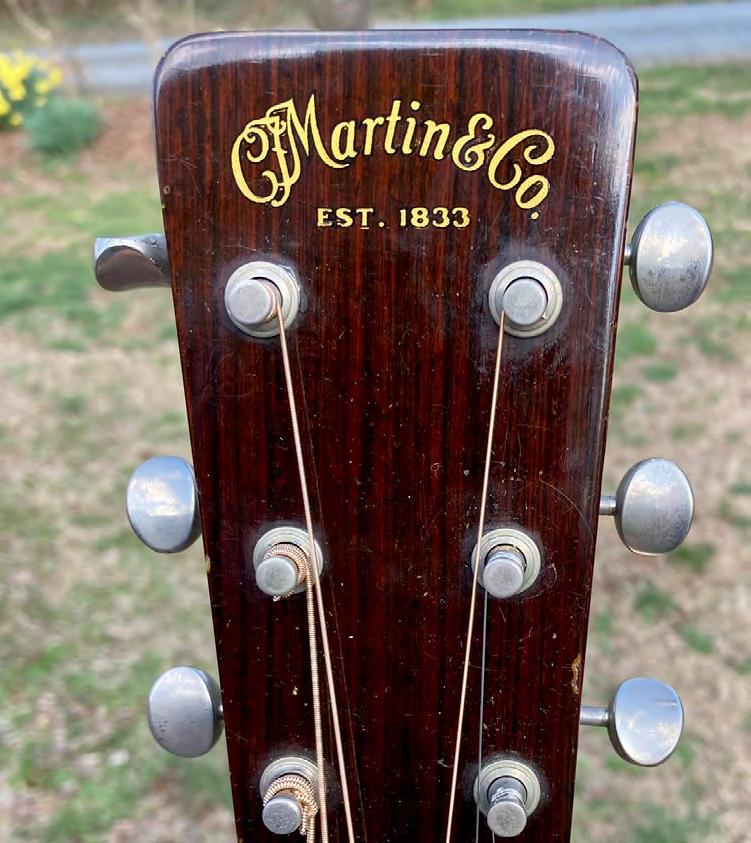

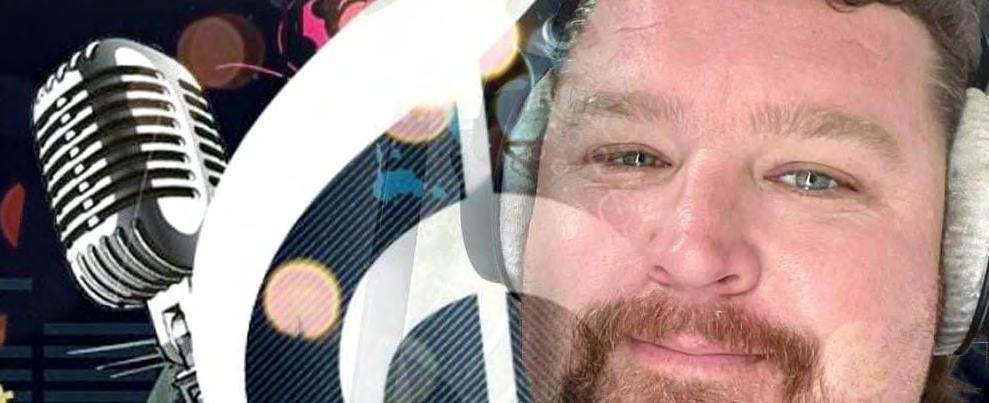
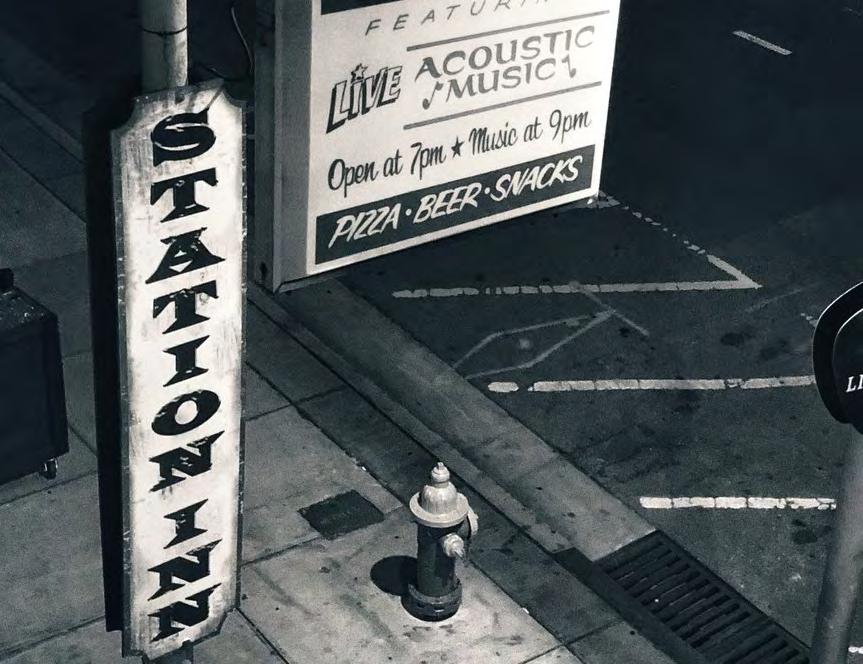

73
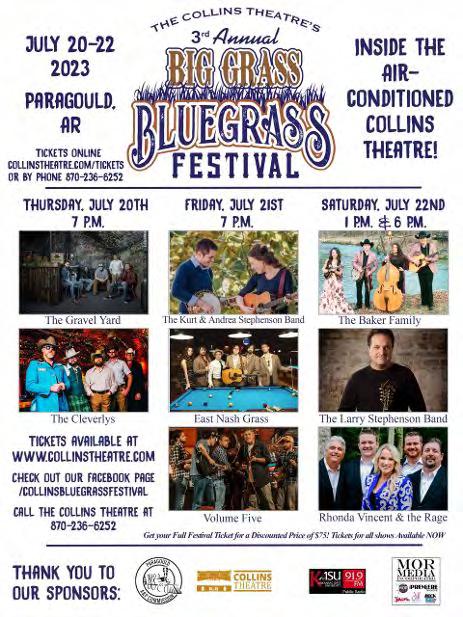
74

75












































































































 Kara Martinez Bachman
Kara Martinez Bachman


















































































